#and shows up as the true final boss of the arcade mode
Explore tagged Tumblr posts
Text
I'm done with granblue versus rising 😤👏 playing as Zooey is fun, everything else about the game is not, so I'll likely not be buying it unless I either can grab it at a huge discount or they add more single player stuff in the future that's hopefully not tied to dlc
#the game is very barebones 💀#CPU is terrible#they lack single player modes that were in the first game#story mode exists but since Zooey was a dlc character she's a very late unlock in that#ALSO they're adding stuff to story mode at a snail's pace just like the regular granblue#also they literally have a character in game (faa-san) that's literally programmed into the game and everything#and shows up as the true final boss of the arcade mode#BUT you have to pay for him as dlc#which is so fucking scummy#either way cygames has disappointed me before and continue to do so#and i'm not giving them any money#at least playing as zooey for a few days was fun 🥹 and i got her super cute true ending art#maybe when they inevitably release the 16th version of this game that'll actually be a definitive version with no dlc and all content#already in game i'll finally buy it if i'm still alive to see it#i would actually consider buying the first game over this if I didn't have to pay for zooey's dlc but alas#also yes i understand that these games rarely focus on single player#isn't gonna stop me from disliking the game for not giving me enough single player stuff to do on top of the other afforementioned problems
1 note
·
View note
Note
PLEEAAASEEEE elaborate on ur thoughts abt RK and R# that’s so fascinating. if u feel up to it ofc
This made me go back and look at Asuka's arcade mode transcript, which made me notice something interesting with the writing but I'll get back to it later. Also, for the record, R# is in fact the only clone. All the people RK fights in the arcade mode are a simulations created by R#, including the final boss. So, in typical Asuka fashion, RK does not tell R# why he made him, and R# naturally wonders the meaning for his existence. He comes up with a few ideas. RK says it's because he wanted to see if he could make a perfect lifeform after seeing ABA and the Valentine sisters (what about Jackie...?). R# figures it's because RK was lonely after not seeing another living person for months. Both of these aren't wrong, but they don't get to the bottom of it. This leads R# to the following: His hypotheses. R# never says directly what they are, but does they involve the facts that R# likes himself and RK does not. These are both the true reasons for R#'s existence. RK wants to commit suicide, but feels like he can't because he has a duty to the world. So, he makes R#, a "better" version of himself to be his replacement. On the first point, if you're looking for any proof, see the following: 1.) Most obviously, this line from R#: "But at least tell me you'll keep walking. Even if you lose your way. As long as one person out there cares about you… It's worth it just to try to keep them happy." 2.) RK literally has to fight for his life against himself at the end of the arcade mode. 3.) R# is wearing the color scheme that has been synonymous with RK throughout the entirety of Guilty Gear, because RK intends for R# to be the "new" Asuka. But the point of Asuka's arcade mode isn't just R# trying to save RK, it's R# trying to show RK that he can't just rip out the parts of himself that he doesn't like. It harkons back to one of GG's big themes of self-actualization and one's sense of self. RK deliberately makes R# to be chatty, friendly, and to like himself, but goes on to be continuously surprised throughout the arcade mode that R# acts like a different person and not just "me but better". Because RK doesn't want to face himself, he doesn't want to self-reflect and comes to terms with who he is, he just wants to tear it apart and be done with everything. The point R# is trying to make is that there is no "me but better". It's just him. If he's going to keep living, RK needs to accept all parts of himself, no matter how horrible he thinks they are. Which isn't to say that RK can't change, it just means he can't deny that parts of himself exist. After all, RK has spent pretty much 90% of his entire 200 or so years of life playing the role of a monster. He says in story mode that he's pretty much never done anything for himself. There's things that he likes and dislikes, but beyond that, he has no idea who he actually is. (In regards to the interesting thing I noticed- It's R# that uses the words "ethically bankrupt monster". RK just says "pathetic ineffectual nerd" to describe himself. Which feels like it should be the opposite in terms of severity. It might just go back to RK's rejection of himself, but it's not like RK isn't acutely aware of the first thing, and he obviously knows very well that it's the reason he wants to die and not the nerd thing. My theory is that he just thinks that he still has the mindset of the ends justifying the means, no matter the cost. He still feels like he needs to take care of the world, but just doesn't see a way that can always be done with a moral lens. Hence R# not having morals. Yeah he's doing it from a distance now with his radio show, but if a large Universal Will-level threat were to show up again, I highly doubt he'd just sit there. So, he wanted R# to have an easier time making the necessary decisions and not being tormented with them later.)
48 notes
·
View notes
Text

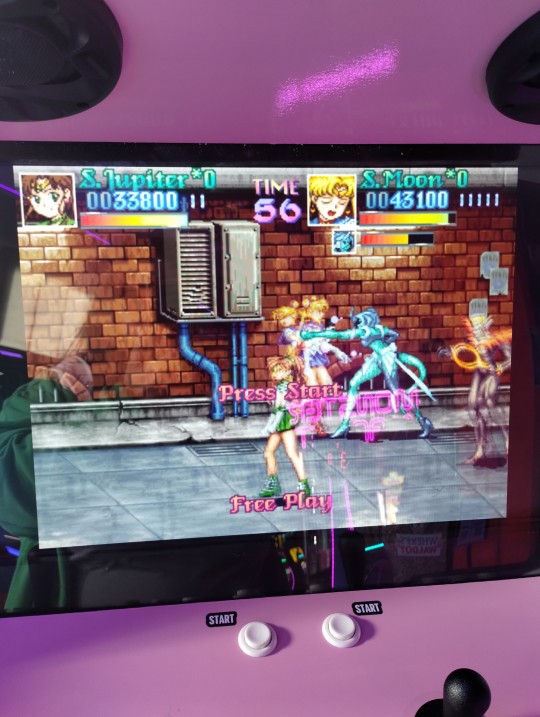
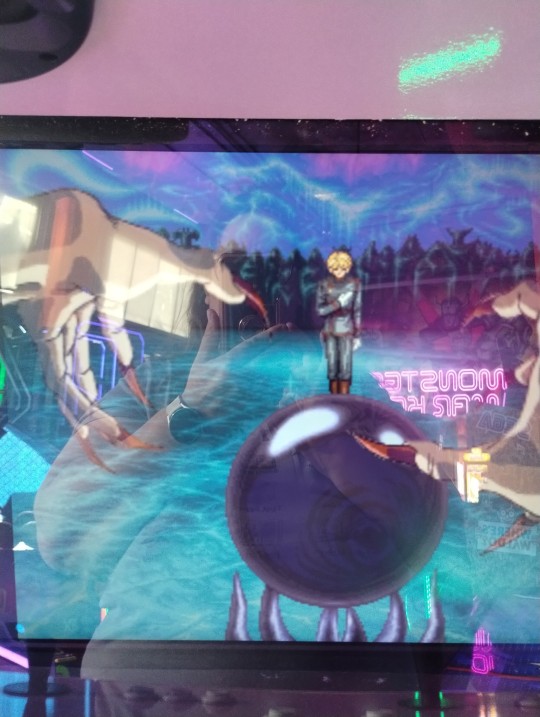
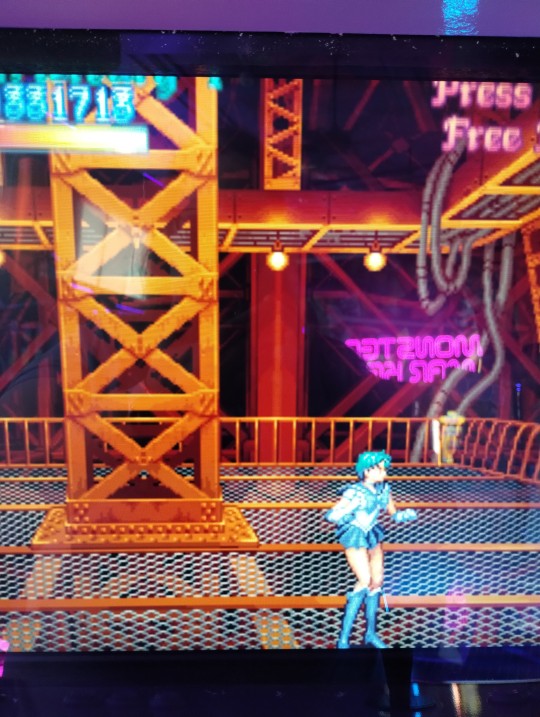
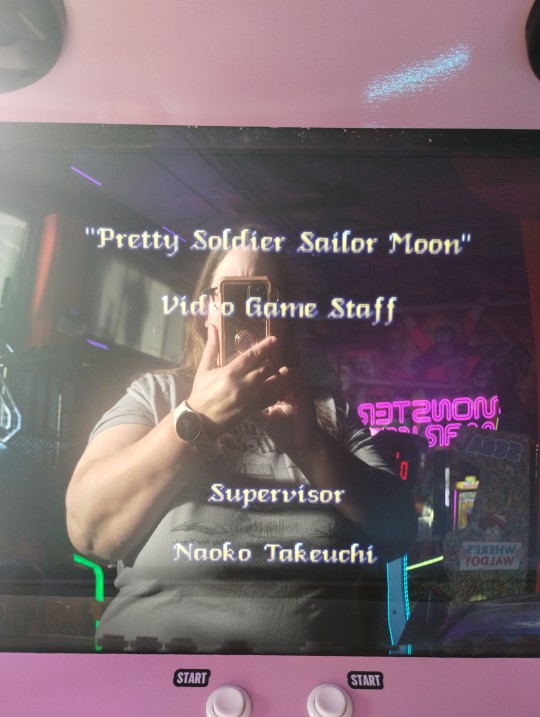
I went to this new arcade today and they had the Sailor Moon arcade game!! Like in an actual cabinet!! Since it was free play and not that busy I just played through the whole game as Mercury. Free play meant unlimited continues, which REALLY helped cause enemies really gang up on you in this game (it's a side-scrolling beat-em-up type game) so I died a lot. It's also not easy to get the crystals you need for your magic attacks; I had to rely on Mercury's one crystal attack (which just has her put on her goggles and say "Iku wa yo" in the on-screen animation, which then hits all the enemies with energy) a lot. I did manage to pull off Mirage Wave (the 2 Crystal one) a few times.
Each stage has a stage boss, which are mostly just various monsters from the show, but in one it's Zoisite, then in the final stage (there are 8 total I think) you fight Zoisite AND Kunzite as a duo and then shortly after Queen Beryl as a true final boss. Whoever translated this game though (I'm guessing it's translated cause it has English text, and this place has QR codes on all the games with Japanese onscreen text leading to a page with translated instructions, though I only actually used that for Taiko no Tatsujin, as the only other Japanese games I played were Project Diva Future Note, which was basically like the other Vocaloid games I've played, and another rhythm game called Wacca that had Japanese audio but English onscreen text) messed up some of the names though, like Kunzite being "Kunzait" or something like that 😂 (To be fair, that does probably reflect the Japanese kana spelling of his name better).
(Also, like I said, I played as Mercury; the first two pics are I think from the machine's "attract mode")
I'm not sure what my final score was but it was high enough that I got to put my initials in. I think I scored like 90,000 points or so in total. (But, like I said, I also had unlimited continues).
At least I did better at that than at this JoJo arcade game, which I sucked at, despite it having essentially the same gameplay mechanics as Street Fighter. (Actually, since it's a Capcom machine, it's probably EXACTLY like Street Fighter). 👇
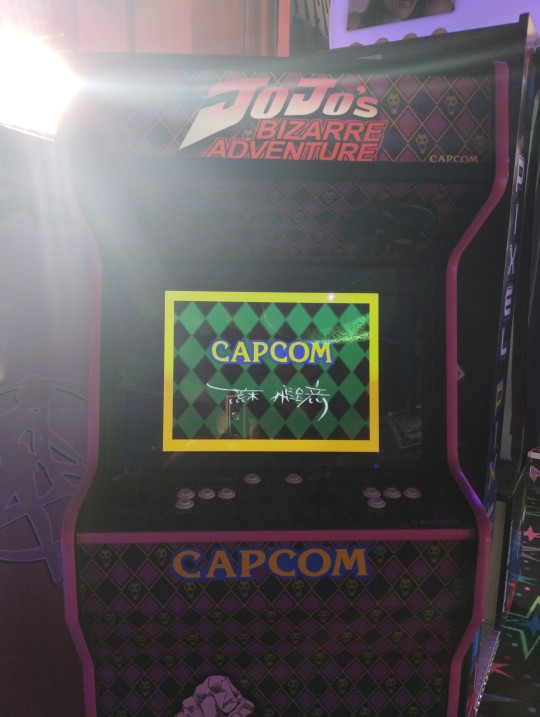
Like, literally I tried playing as both Dio AND JoJo and I lost both times 🫤 And I'm no stranger to arcade fighting games. (At least I redeemed myself later playing Street Fighter IV Ultra, which I did well at for the brief time I was able to play before my food buzzer went off).
2 notes
·
View notes
Note
Okay, so maybe I'm insane, but you could argue the different ending images from Rising tell a story
You can play standard Arcade mode, which is seven rounds you have to beat consecutively. Six random opponent + Beelzebub as the final boss. But these new images are unlocked (apparently) by beating six random opponents with a special finisher, then facing Avatar Belial as your boss and then Lucilius. That's the "true" ending. You could even argue it's alluded to because the coloring of the Versus artworks looks a bit washed out, while the coloring on the new art is super crisp
My point is made especially by the WMTSB gang's pictures, but you could argue that in the old ending, Percy is reading by himself but his true ending is looking pretty while going on a horseback ride. Presumably with someone, likely the MC. The world is saved now, time to enjoy it with his precious person
Or Lancelot was having a lunch date with Vane, but his true ending is him training while the other Dragon Knights look on. He's preparing himself for new challenges, now that he's overcome Lucilius.
I haven't seen all of them yet, obviously
Anyway, the most important ones for my theory
Beelzebub's old art had him posing while Lucilius was in the background, his back turned. The unattainable specter of the rival he's trying to overcome is still haunting Beelzebub. Meanwhile, in the new ending that is achieved by beating Lucilius, Bubs is having a relaxing bath in wine. He's overcome his rival and is now able to move on.
Belial, in the old one, was taking a bath and being sexy. Basically killing time like he had for 2000 years, waiting for Lucilius to return to him. Now that Lucilius is back and Belial has passed his performance review, he
1) either asked him out on a date finally and got predictably stood up
2) or realized Lucilius isn't all that and is finally ready to move in with someone else and that's who he's on that date with
That depends on how delusional you are or which you'd prefer for him, ig
Avatar Belial is much the same, lounging around and enjoying his power in the old one, eating an apple, something symbolic of Lucilius and his connection to him, as Lucilius loves apples and it plays into the whole forbidden fruit of knowledge and all that. Meanwhile, Avatar Belial is still very much flexing in the new one, surrounded by what looks like six skulls. The six random opponents he faced, as Avatar Belial's victory screen has him murder his opponent. Now he's either waiting for new orders from Lucilius, more blood and skulls to add to his collection, or he killed him too and is getting ready to destroy the world by himself
Anyway, that's my theory
Either way, they're all genuinely nice artworks showing the characters being themselves and having a good time
Oooh that makes a lot of sense actually
i do think the idea that the first ending showcase where they are when they achieved some big feat but didn't finish it yet VS the last ending being how they decide to rest AFTEr beating Lucilius is probably the assumption yeah, which does lead to a lot of theories on why they decide to relax one way or another, obviously
but i think you're nailing it in term of Bubs and Belial. Both of them wanted and waited for Lucilius, so their behaviors went from yearning from him to actually enjoying themselves now that Lucilius is there.
it's a pretty good reading imo and i have nothing to add! it's so nice!!!
i love those arts so much
3 notes
·
View notes
Note
Gaming ask meme: 1, 5, 10
1. Name a game that is really important to you
I would say Fallout New Vegas but that's not true. I would say Gears of War but that's also not true.
This one is a really good but difficult question for me because if I were to take account of every game I've played on PC and mostly the PS2, with also some emulated games that I want to get back...somehow...(I know how...the question honestly is WHEN... *side eyes brain* >.>)....there's...there's games I've played that were very very important to me that shaped what and who I am today.
But to save the trouble cos I got 2 more questions to answer after this: It's a tie between the Deus Ex franchise and Destiny 2
I'll go more into Destiny 2 for now because that's where I met a lot of good people that I still keep in touch with.
It's a game that I have the most listed accomplishments ever that I can go back to and yeah show off but mainly to recognize that I was able to accomplish SOMETHING in my 30's. My 30's were (and in some ways still are) very very rough, but it's hopefully a decade that I can remember more positively than my 20's and teens.
I've got 2 Triumph Pins and won the 2020 Guardian Games as a hunter. I've completed several raid runs with friends, AND I did 2 Day One raid openings (though sadly I never beat them in Contest Mode).
As much as I complain about the game mode Gambit, it's something I got good at in and with Spite. I won't ever say I'm a top player in Gambit. Far from it actually if I were to look up my stats on Destiny Tracker, but I've gotten good to say that I've put the work in and the experiences made me Good enough to be a reliable teammate.
And I've gotten skilled with a weapon class that honestly more games NEED to get into because there's SO MUCH FUCKING POTENTIAL-- *deep breath*...I am enamored by Bungie's bow mechanics and designs so yes...I'll just leave it at that.
Anywho, maybe one day I'll rb this (if I remember >.>) and go into why I loved the Deus Ex franchise just as much.
5. Name a game that that everyone else didn’t care for that you enjoyed
Hmm.....*thinking*
Dirt 2 and 3
I LOVE rally racing a lot and honestly those two games really showed how much I loved it.
At first it was more like a connection to a childhood time where there was this isometric rally racing arcade game that I couldn't beat for the life of me and spent way too much money on at the time. But really it's because Dirt 2 and 3 were the first time I got to play a racing game that made me understand racing as a whole a lot better than the Need For Speed franchise ever could.
Plus the intensity of each game's era was awesome as hell and it's sad that...well...hmm...I could try to find these two games elsewhere for sure, but again it's sad that the copies I have aren't playable anymore (even offline) =(
So...maybe one day I'll find another copy of each game that works with the PC I have currently :3 >:3c
10. Name a favorite obscure video game
asdffkjlgh omfg so there was this arcade game that was MASSIVE in actual size because it seated 6 players and was a rail space shooter that you literally had to ENTER INTO because it was like...a total simulator of sorts and I fucking forgot the name of it but I beat it on MAME (Multiple Arcade Machine Emulator), and it was a game that I was OBSESSED with in my teens...maybe younger than that actually o.o
This arcade game was so cool because it really brought out the cooperative spirit in people. Some groups I played with were silent but would use the games visual cues to signal to the other players. Some groups were very vocal (not swearing really. since I was a kid any adult that played it kept swearing to a bare minimum) and would tell the other players where to shoot and what to fight off. It was so cool because at the time, NO ONE was able to reach the final boss and beat the name. Not even the badass solo players that got really far into the game.
I honestly miss that arcade game so much and tbh if the world (yes world not just the US) EVER brings back arcade emporiums full swing, I want to see game devs do a full from-the-ground-up remake of that arcade game and even put their heart into it so much to make a very awesome and compelling story!
Pipe dream yes but eh...a sweet butch gaymer trans gal can dream right? ^.^
7 notes
·
View notes
Text
2020 Gameological Awards
Over on the Gameological Discord, we have an annual tradition of writing up our games of the year not as a ranked list but rather as answers to a series of prompts. Here are my personal choices for the year that was 2020.
Favorite Game of the Year

I didn’t know what to expect when I walked into Paradise Killer. I knew that I liked the vaporwave resort aesthetic from the game’s trailer and figured I was in for a Danganronpa-style murder mystery visual novel with an open-ended murder mystery at its core. Those assumptions were… half-right? The game definitely plays out like the exploration bits of Danganronpa set on the island from Myst but with far simpler puzzles. What I didn’t expect was to fall so deeply in love with the environment—its nooks and crannies, its millennia of lore, its brutalist overlap of idol worship, consumerism, and mass slaughter. It makes sense that the world of Paradise Killer is its strongest feature, since the cast of NPCs don’t really move around, leaving you alone with the world for the overwhelming majority of your experience as you bounce back and forth between digging around for clues and interrogating potential witnesses. And despite what the promo materials indicated, there IS a definitive solution to the crimes you’re brought in to investigate, the game just lets you make judgment based on whatever evidence you have at the time you’re ready to call it a day, so if you’re missing crucial evidence you might just make a compelling enough case for the wrong person and condemn them to eternal nonexistence. Am I happy with the truth at the end of the day? No, and neither is anybody else I’ve spoken to who completed the game, but we all were also completely enthralled the entire time and our dissatisfaction has less to do with the game and more to do with the ugly reality of humanity. I’ve always been of the mindset that “spoilers” are absolute garbage and that a story should be just as good whether you know the twist or not and any story that relies on surprising the audience with an unexpected reveal is not actually that good a story, but Paradise Killer is a game about piecing together your own version of events so I feel that it’s vital to the gameplay experience that people go in knowing as little as possible and gush all about it afterwards. Just trust me, if the game looks even remotely intriguing to you, go for it. I’ve had just as much fun talking about the game after I finished it with friends just getting started as I did actually solving its mysteries myself.
Best Single Player Game

I honestly missed out on the buzz for In Other Waters at launch, so I’m happy I had friends online talking it up as Black Friday sales were coming along. The minimal aesthetic of his underwater exploration game allows the focus to shift more naturally to the game’s stellar writing as a lone scientist goes off in search of her mentor and the secrets they were hiding on an alien world. It only took a few hours for me to become completely absorbed in this narrative and keep pushing forward into increasingly dangerous waters. In Other Waters might just be the best sci-fi story I experienced all year and I’d highly recommend it to anyone who enjoys sci-fi novels, regardless of their experience with video games.
Best Multiplayer Game
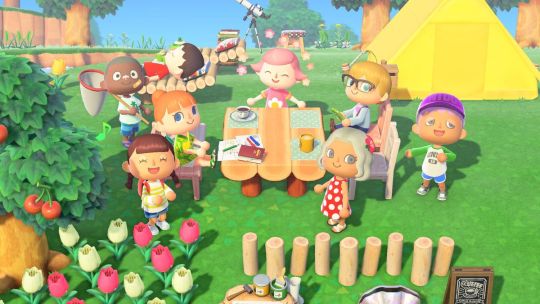
Look, we all know this year sucked. 2020 will absolutely be chronicled in history books as a fascinating and deeply depressing time in modern history where we all stayed inside by ourselves and missed our friends and family. It was lonely and it was bleak. Which is why it made my heart glow so much more warmly every time I got a letter from an honest-to-goodness real-life friend in Animal Crossing New Horizons. Knowing that they were playing the same game I was and hearing about their experiences and sending each other wacky hats or furniture, it lightened the days and made us feel that little bit more connected. Sure, when the game first launched we would actually take the time to visit one another’s islands, hang out, chat in real-time, and exchange gifts, but we all eventually got busy with Zoom calls, sourdough starters, and watching Birds of Prey twenty-two times. Still, sending letters was enough. It was and still is a touching little way to show that we’re here for one another, if not at the exact same time.
Favorite Ongoing Game
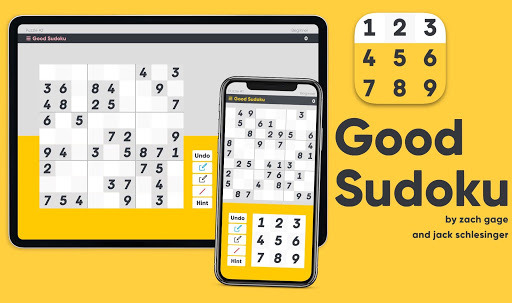
Zach Gage is one of my favorite game designers right now, and when I heard he was releasing a game called Good Sudoku I was sold sight unseen. The game as released was… fine. It’s sudoku and it’s pleasant, but it was also buggy and overheated my phone in a way I hadn’t seen since Ridiculous Fishing (also by Zach Gage) seven years ago. Thankfully, the most glaring bugs have been fixed and I can now enjoy popping in every day for some quick logic puzzle goodness. Daily ranked leaderboards keep me coming back again and again, the steady ramp of difficulty in the arcade and eternal modes means I can always chase the next dopamine rush of solving increasingly complex puzzles. It’s not a traditional “ongoing” game the way, say, Fortnite and Destiny are, but I’m happy to come back every day for sudoku goodness.
Didn't Click For Me

With Fortnite progressively losing me over the course of 2020, finalizing with my wholesale “never again” stance after Epic boss Tim Sweeney compared Fortnite demanding more money from Apple to the American Civil Rights movement (no, absolutely not), I dipped my toe into a number of new “battle pass”-style online arena types of games, and while Genshin Impact eventually got its hooks into me, Spellbreak absolutely did not. With graphics straight out of The Dragon Prince and the promise of a wide variety of magic combat skills to make your character your own, the game seemed awfully tempting, but my first few experiences were aimless and joyless, with no moment of clarity to make me understand why I should keep coming back. Maybe they’ll finesse the game some more in 2021, or a bunch of my friends will get hooked and lure me back, but for now I am a-okay deleting this waste of space on my Switch and PC.
"Oh Yeah, I Did Play That Didn't I?"

I remember being really excited for Murder By Numbers. Ace Attorney-style crime scene investigation visual novel with Picross puzzles for the evidence, art by the creators of Hatoful Boyfriend, and music by the composer of Ace Attorney itself?! Sounds like a dream come true. But the pixel-hunt nature of the crime scene investigations was more frustrating than fun, the picross puzzles were not particularly great, and the game came out literally a week before the entire world went into lockdown which makes it feel more like seven years ago than just earlier this year. I remember being marginally charmed by the game once it was in my hands, but as soon as my mind shifted to long-term self care, Murder By Numbers went from hot topic to cold case.
Most Unexpected Joy
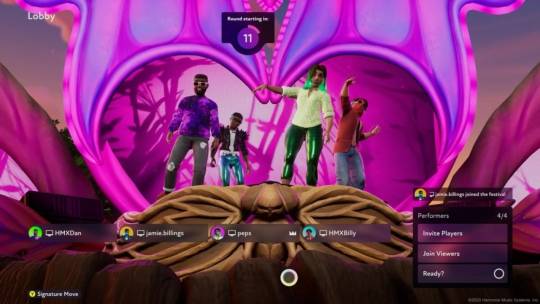
I was looking forward to Fuser all year. As a dyed-in-the-wool DropMix stan, the prospect of a spiritual sequel to DropMix on all major digital platforms without any of the analogue components was tremendously exciting, and I knew I’d have a lot of fun making mixes by myself and posting them online for the world to hear. What I didn’t expect, however, was the online co-op mode to be such a blast! Up to four players take turns making 32 bars of mashups, starting with whatever the player before handed them and adding their own fingerprints on top. It sounds like it should just be a mess of cacophony, but every session I’ve played so far has been just the best dance party I’ve had all year, and everyone not currently in control of the decks (including an audience of spectators) can make special requests for what the DJ should spin and tap along with the beat to great super-sized emoji to show how much they’re enjoying the mix. Literally the only times my Apple Watch has ever warned me of my heightened heart rate have been the times I was positively bouncing in place rocking out to co-op freestyle play in Fuser.
Best Music
youtube
Only one video game this year had tunes that were so bumpable they were upgraded to my general “2020 jams” playlist alongside Jeff Rosenstock, Run the Jewels, and Phoebe Bridgers, and that game was Paradise Killer. 70% lo-fi chill beats to study/interrogate demons to, 20% gothic atmospheric bangers, 10% high-energy pop jazz, this soundtrack was just an absolute joy to swim around in both in and out of gameplay.
Favorite Game Encounter
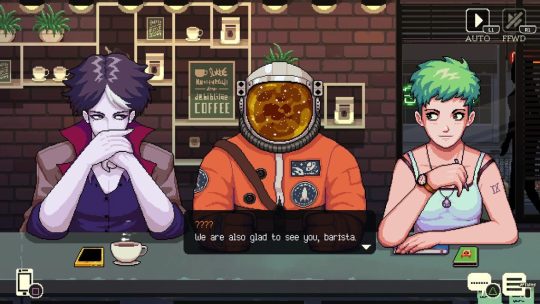
It’s wild that in a landscape where games let me live out my wildest fantasies, the single moment that lit me up in a way that stood out to me more than any other was serving Neil the right drink in Coffee Talk. Over the course of the game, you serve a variety of hot drinks to humans, werewolves, vampires, orcs, and more, all while chatting with your customers and learning more about their lives and relationships. The most mysterious customer, though, is an alien life form who adopts the name Neil. They do not know what they want to drink and claim it doesn’t make a difference because they cannot taste it. Everybody else wants *something*. Neil is just ordering for the sake of fitting in and exploring the Earth experience. It’s only in the second playthrough that attentive baristas will figure out what to serve Neil, unlocking the “true” ending in the process. Seeing the typically stoic Neil actually emote when they tasted their special order drink? What an absolute treat that was.
Best Free DLC of the Year

It’s still only a couple of days old at the time I’m writing this, but Marvel’s Avengers just added Kate Bishop, aka Hawkeye, and THANK GOODNESS. Almost every character in the game at launch just smashed the endless waves of robot baddies with their fists and that looks exhausting and uncomfortable. Hawkeye (the game calls her Kate Bishop, but come on, she’s been Hawkeye in the comics for over 14 years, let’s show her some respect) uses A SWORD. FINALLY! Aside from that, I’m just having a blast shooting arrows all over the place. She and Ms Marvel are the most likable characters in the game so far, so I hope they keep adding more of the Young Avengers and Champions to the game, and if the recently announced slate of Marvel movies and tv shows are any indication (with America Chavez, Cassie Lang, and Riri Williams all coming soon to the MCU), that seems to be what Marvel is pushing for across all media
Most Accessible Game
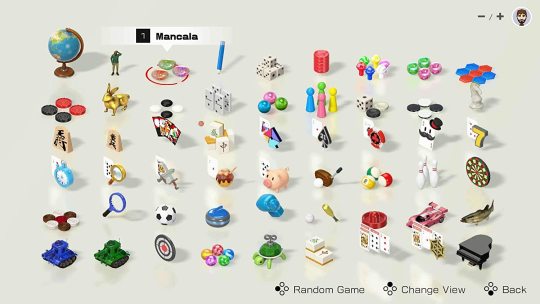
Nintendo is, first and foremost, a toy company. They got their start in toys and cards long before video games was a thing, and they still do more tests to ensure their video game hardware is childproof than anybody else in the industry (remember how they made Switch cartridges “taste bad” so kids wouldn’t eat them?). This year, Nintendo got to rekindle some of their throwback, simplistic, toys-and-cards energy with Clubhouse Games: 51 Worldwide Classics, a Switch collection of timeless family-friendly games like Chess, Mancala, and Backgammon, along with “toy” versions of sports like baseball, boxing, and tennis for a virtual parlor room of pleasant time-wasters. The games were all presented with charming li’l explainers from anthropomorphic board game figurines, and the ability to play quick sessions of Spider Solitaire on the touch screen while I binged The Queen’s Gambit on Netflix made Clubhouse Games one of my most-played titles of the year. Plus, local play during socially-distant friend hangs was an excellent way to make us feel like we were much closer than we were physically allowed to be as friends knocked each other’s block off in the “toy boxing” version of Rock’em Sock’em Robots.
"Waiting for Game-dot"

I get that everyone loves Disco Elysium. I saw it on everyone’s year-end lists last year. I finally bought it with an Epic Games Store coupon this year. This year was a long enough slog of depressing post-apocalyptic drudgery, I didn’t want to explore a whole nother one in my leisure time. I’ll get to it… someday.
Game That Made Me Think
youtube
Holovista was an iPhone game I played over the course of two or three days based on the recommendation of some trusted colleagues on Twitter and oh my goodness was I glad that I played it. What starts as a chill vaporwave photography game steadily progresses into an exploration of psychological trauma, relationships with friends and family, and the baggage we carry with us from our pasts. In this exceptionally hard year, I badly needed this story about spending time alone with your personal demons and finding your way back to the people who love and support you. Just like with Journey and Gone Home, I walked away from Holovista feeling a rekindled appreciation for the people in my life.
#video games#holovista#paradise killer#animal crossing#animal crossing new horizons#spellbreak#good sudoku#fuser#dropmix#in other waters#marvel's avengers#avengers#clubhouse games#coffee talk#2020
11 notes
·
View notes
Text
Tekken
In our Soundtrack Sunday series, we take a look at the music of fighting games, track by track!
For the fifth instalment, Shaun Eddleston takes a look at the music of 1994’s Tekken…
(For the purpose of this article, only the Arcade version of the game’s soundtrack is being covered).
In 1994, 3D fighting games were still in their infancy. SEGA’s first fighting game experiment in the form of Dark Edge and the boundary-pushing Virtua Fighter had barely been out for a year, and games such as Battle Arena Toshinden were still just around the corner for the next generation of home consoles such as the Sony PlayStation and SEGA Saturn.
Namco wanted in on the action, so enlisted the talents of Virtua Racing & Virtua Fighter game designer Seiichi Ishii to help develop 3D fighting game of their own, based on a hardware demo that was initially developed to show off some fancy new graphics off to investors. What started off as a game called “RAVE WAR” would eventually go on to become not only one of the most successful and longest-running fighting game franchises, but one of the biggest selling video game series of all time; Tekken.
As the technology was still somewhat limited at the time, Tekken’s stages were a simple affair. A seemingly infinite scrolling plane placed in front of some parallax backgrounds to give the impression of depth, each of these fighting arenas required a little bit more oomph to push forward and create a suitable, varied atmosphere in which players could beat each other up.
That’s where the music comes in. As Tekken was such an early entry in the realm of 3D fighters, the soundtrack played a considerably larger role in establishing how the game felt than in later entries.
So, how does the original soundtrack holdup today?
Let’s find out…
The game’s introduction is fairly non-eventful in its 20-second runtime, but it does make good use of the game’s stereo mix by panning left and right to create a more immersive effect, and reminds me a little bit of elements found in the PlayStation startup jingle.
Tekken’s character select music is a loop of what initially appears to be a fuzzy, overdriven funk bassline over a simple drumbeat, but to me personally, there was always something about this version that didn’t sit right with me. Upon listening closer, I think I’ve figured out what it is.
Behind the upbeat bass that is designed to get players pumped up before a fight, there’s two droning chords being played in the background that elicit a very serious, uneasy tone. Its a strange sensation that’s also present in the PlayStation version of the soundtrack (although it’s not as strong, thanks to better quality remixing!)
“Marine Stadium, Japan” is where the soundtrack has the most fun with the stereo mix, creating a dizzying effect by throwing samples at the listener from all directions in the left and right speaker. Once the track gets moving, there’s a call & response going on between many of the tracks separate elements, running a fine line between being a disjointed mess and a brilliantly cohesive piece.
Luckily the rhythm section and background pads do a great job of keeping things in check.
Definitely one of my favourites in the game.
“Chicago, USA” is probably the grittiest track of the OST, and is probably closer to what a lot of the game’s music sounds like in the modern era than the rest of the tracklist.
The fuzzy bass tone of the character select screen makes yet another appearance here, and immediately starts to make each of the “verse” sections feel incredibly busy and muddies the entire mix straight away.
The chorus, although very brief, saves the song in a big way. The soaring keys, accompanied by some fun percussive claps, make this one of the most enjoyable songs that still holds up really well today.
On a related note, the arrange version found in the PlayStation port is flawless.
The most immediate thing I noticed about this track is just how loud and distracting the bass is. It rumbles throughout the majority of the runtime, and almost ruins the whole experience for me, that is until the bass drops out and allows listeners to focus in a bit more on the tracks other elements.
Once you get past the overpowering synth bass, this is actually a really fun track. Utilising samples of traditional Chinese stringed instruments and gong hits, it’s a high energy track that perks up the players fighting in the mountainous stage.
Imagine a hard-hitting techno remix of Chun-Li from Street Fighter II’s music and you’ve got the right idea.
“Angkor Watt, Cambodia” is probably the closest that the game comes to an industrial sound, and I mean that in a literal sense. The drums and bass is accentuated with what sounds like stylised machinery interspersed with synth leads for the whole track. This robotic selection is an odd choice to use for a stage that’s based on the real life Angkor Watt (i.e. a complex of ancient temples in Cambodia, NOT a factory filled with heavy machinery).
The track also ends before it has the chance to build up into anything really interesting, and remains as a bit of a teaser for me.
“Fiji” is unlike anything else in the Tekken soundtrack, and is arguably one of the series’ most iconic pieces of music (it gets revisited a handful of times throughout the franchise’s long history). The track dials things up into party mode, with steel drums and a catchy salsa beat that really makes you feel like you are on holiday on a tropical island, with a bassline that you’d expect to hear in a bustling nightclub.
A true highlight of the soundtrack, and most definitely the biggest earworm of the whole tracklist.
With “Acropolis, Greece”, we steer into something with a much more dramatic mood.
While the drums and bass for most of the song leave a lot to be desired in terms of differentiating themselves from damn near every other song in the soundtrack, its the the chorus that saves the whole composition. Backed up by some choir keys that remind me of Angel Dust-era Faith No More (the best era, by the way!) and some military-style drumming that’s sprinkled throughout, it builds up to something pleasant, even though it doesn’t quite reach the majesty of the location’s namesake.
“Kyoto, Japan” follows in the footsteps of “Sichuan, China”, in that it utilises samples of traditional instruments from the location’s culture.
This is another track that makes great use of the stereo mix, with the instruments constantly in flux from the left to right speaker (and vice versa). The song does feel a little choppier than the rest of the soundtrack in places though, and the constant “un-tiss-un-tiss-un-tiss” drumbeat mixed together with the percussion samples of blocks being hit makes the song sound like something from the Samurai Shodown games if they were all on ecstasy.
“King George Island, Antarctica” is one of the more interesting items on this fighting game menu, as the song is driven forward by something outside of the simple drumbeat and funk bassline. Instead, it’s powered by an ongoing drone sound hidden in the background. While not quite in Sunn O))) territory, it’s something that makes the track feel unique to its peers, even though it largely contains a lot of the same elements as them.
This one took me by surprise.
Most of the runtime of “Venezia, Italy” sees the music simmering away comfortably, then once the chorus hits, it erupts into a slightly operatic, adventurous display of strings and choirs. Not only that, but for the latter half of the brief chorus, the drum beat instantly shifts into a jazzy offbeat section that definitely threw me off in terms of where I was expecting the music to go.
It’s a gamble that ultimately pays off, and it’s one that results in one of the more underrated tracks in the collection.
“Windermere, U.K.” is where the quality of the game’s music takes a hard hit.
Everything in the song sounds like you’re listening to it through a wall, with the individual instruments being drowned out by the overblown bass and frankly dull drum loops, and even then, the synthetic saxophone sections of the song don’t sound very interesting either. It’s a couple of minutes that holds the entire OST back.
At least the Arrange version in the following year’s PlayStation port was an improvement.
From the game’s weakest track, we head straight into one of the best moments in the entire OST.
“Monument Valley, USA” is one of the most ominous, evil-sounding stage themes that you’re likely to encounter in any fighting game. Just over a minute of harsh windy soundscapes, thunderous gongs, grandiose strings and monk chants that feel more like a summoning of an ancient demon than an actual song. It’s such a deviation from the rest of the music in Tekken, almost to the point where it could be from a totally different game altogether.
The PlayStation version of this song is rightfully in my top 10 favourite fighting game tracks of all time.
Tekken’s final credits music is an absolute pleasure to listen to. In just a couple of minutes, it effectively melds together all of the different vibes of each stage in the game without resorting to just clipping them together as a cheap montage.
Besides, it’s just a relief to have something relatively soothing after dealing with the horrid AI of Heihachi as a final boss.
Overall, the soundtrack to the very first Tekken game is pretty far away from people may be used to from the high intensity of the modern entries in the franchise.
Instead of punishing dubstep and songs you’d expect to hear from a harder-edged Dance Dance Revolution game soundtracks (is that even a thing?), the music selection here is much simpler and way more subdued.
Tasked with trying to represent the various locations from around the world, Namco Sounds did an admirable job getting the vibe right for each stage. From the absolute party of “Fiji” and the sports broadcast jingle of “Marine Stadium, Japan” to the gritty club beats of “Chicago, USA” and the windy soundscapes of “Monument Valley, USA”, the Tekken soundtrack is a varied, interesting mix that not only gives each landmark and setting more personality, but also attempts to set the bar for a series that has since become known for its great music.
Now, time to try and get “Fiji” out of my head until Tekken 2’s edition of Soundtrack Sunday…
The soundtrack is available on vinyl here.
Are you a fan of the original Tekken’s music? Let us know your thoughts in the comments below!
1 note
·
View note
Text
Saturn Games
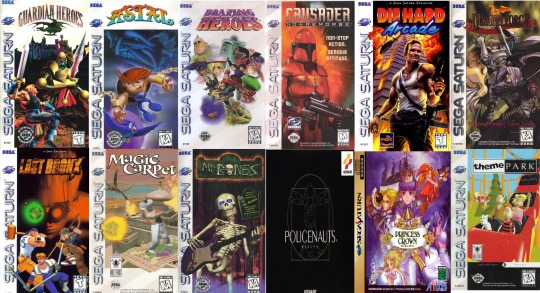
12 Sega Saturn Games All Gamers Should Play
After the 16-bit console war between Sega and Nintendo, Sega started to noticeably lag behind. However, just because consoles like the Saturn and the Dreamcast weren’t extremely successful in sales doesn’t mean their library was lacking in awesome and weird genre-bending titles.
Not every franchise got to “graduate” from the fifth-generation of consoles, but that doesn’t mean they aren’t fantastic. Modern gamers might not know much about these, but these are truly memorable Games From Sega’s console-exclusive heyday. Get your hands on these games however you can; they’re really unique experiences on a very distinctive console.
Guardian Heroes
Before Castle Crashers showed off how fun a beat-em-up can be with RPG mechanics and simple combos, there was Guardian Heroes. This game was well-received when it originally came out on the Saturn, but now, it’s largely forgotten. The series has a spinoff on the GBA and a port to Xbox 360/Xbox One, but other than that, there’s been no word of a sequel or revival–not even a rumor.
The game controls like a fighting game with juggle combos, aerials, special moves, and a mana bar. There are only six characters playable in the story mode (two unlockable), but there are fun multiplayer versus modes to mess around with. After defeating a character in the story mode, they’re unlocked for use in multiplayer, and the combos can get pretty crazy with six concurrent players.
Dragon Force
Dragon Force is from an era where “RTS/Tactics RPG” wasn’t that unique of a genre. Nowadays, we have Fire Emblem, but Dragon Force was smack-dab in the middle of a golden age of Langrisser, Fire Emblem, Final Fantasy Tactics, and many other SRPG hits.
Something that sets Dragon Force apart from its peers is that it focuses on large-scale battles instead of small-scale ones. The fights aren’t duels like in Fire Emblem; generals can collide with 100 troops on each side, duking it out in skirmishes. Time passes in “weeks,” which lets the plot advance while you make out-of-battle decisions.
The game sold well at the time, but its sequel (also on the Saturn) never left Japan. No one spoke much about this game after the Sega Saturn kicked the bucket, which is a real shame; Dragon Force is a true diamond in the rough.
Astal
Action platformers were falling out of vogue by the time the Sega Saturn hit the stores. Astal, however, came out early in the system’s lifespan, and was still able to capitalize on the craze. The titular character Astal can grab and throw objects or enemies. He can also slam the ground and blow big gusts of air. On top of that, he has a super meter that commands his bird companion to bounce around, knocking out all enemies on screen.
This is a fun asymmetric co-op game, too. The second player plays as Astal’s bird companion, instead of just a palette-swapped version of Astal. The bird has his own unique set of attacks, making this game worth checking out with a friend.
Astal is short, but has challenging gameplay backed up by a unique hand-drawn aesthetic. Many indie games nowadays use hand-drawn graphics as a selling point, but it was really rare during the fifth console generation. The main character has had cameos in other Sega games since, but there’s no word of a sequel, revival, or crossover with another franchise.
Mr. Bones
At its core, Mr. Bones is an action platformer about a reanimated skeleton that can lose and regain limbs instead of using health or lives. That’s not totally accurate, though; certain levels were based on non-platforming genres, with rhythm game elements, Breakout-style gameplay, or perspective changes. It’s more like Lawnmower Man on the SNES rather than Castlevania.
The first run-through of the game is extremely silly and fun, especially going in blind. Getting used to the “skeletism” meter to replace the traditional health meter takes some getting used to, but it creates a fun sub-game of trying to hang onto all your bones. It really sucks not having your legs and being unable to jump in a platformer. Mega Man wouldn’t be as fun if he had to climb on the ground with his arms–but that’s part of what makes Mr. Bones so hilarious.
Mr. Bones had a very polarized reception, with some critics praising how much variety there was in gameplay while some others would have just preferred a normal platformer. This isn’t the greatest platformer of all time, but sometimes it’s just worth playing a game where the developers threw caution to the wind and put in every single gameplay function they felt like.
Policenauts
Before Hideo Kojima made Metal Gear Solid, he was making story-focused adventure games for a variety of platforms. After finishing the cult cyberpunk game Snatcher, he set to work on Policenauts, a sci-fi story about astronauts that are also law enforcement officials. It came to the PlayStation, the PC-9821, the 3DO, and of course, the Saturn.
Policenauts is like a cross between a point-and-click adventure game and a visual novel. It’s interactive, and requires the player to be a good detective and figure out the right dialog options to select and the right items to interact with. The Saturn version is also considered superior to other ports because it has first-person light gun segments not seen elsewhere.
There is an unofficial translation patch available for the Saturn, which uses dialog from an earlier fan translation for the PlayStation. If you want to see where Kojima honed his writing chops, play Policenauts. You’ll be the cool person that’s already played it once it gets an HD remaster.
Note that this came was never released in the U.S. and can only be played on Japanese Sega Saturn Consoles!
Princess Crown
Do you like classic beat-em-ups? How about collectible armor and items? Do you like a cutesy anime style backed up by serious gameplay? What about classic RPG enemies and locations with high-quality pixel art? If you answered yes to any of these, pick up Princess Crown.
Princess Crown is the brainchild of Capcom veteran George Kamitani. Because it was released near the end of the Saturn’s lifespan, it was a commercial failure, which led to Kamitani getting blacklisted in the games industry. He later went on to found Vanillaware, which re-established him as a developer.
Princess Crown’s core gameplay went on to spawn many spiritual successors, such as Odin Sphere, Muramasa: The Demon Blade, and Dragon’s Crown, all made by Kamitani. It’s great for the industry to have specialists like him.
Note that this came was never released in the U.S. and can only be played on Japanese Sega Saturn Consoles!
Mystaria: The Realms of Lore/Blazing Heroes
If you’re a fan of classic grid-based tactics RPGs, give Mystaria a try. The graphical limitations of the Saturn give it a unique, blocky, and vibrant aesthetic. There’s twelve special characters for you to get, and the story changes depending on who you want to recruit first. The story is not that complex, but being non-linear is a huge plus for keeping gamers engaged.
The menu system for navigating combat is cumbersome at first, but once you get the hang of it, it’s fluid and fast. Plus, there’s a first-person camera mode, which is novel and weird. Try to play it in that mode, because you can’t get that in many other tactics RPGs.
Take a look at Mystaria if you feel like seeing what was once considered “next generation.” The game might seem archaic or underdeveloped now, but when it was released, Mystaria heralded what RPGs were going to look like, with 3D spells and effects backed up by camera changes to create cinematic fights.
Mystaria was released in North America as Blaze Heroes; they are the same game!
Crusader: No Remorse
There aren’t many games by Western developers on this list, but Crusader: No Remorse has definitely earned its entry. It uses pre-rendered graphics with an isometric perspective, much like the original Fallout or Diablo games. The gameplay, however, focuses on shooting, action, and interactable environments rather than RPG mechanics.
The environment destruction and playability is really where this game shines. There are alarm switches, non-combatants, puzzles, and a perspective that supports tactical gameplay rather than run-and-gun shooting. Most of the objects you see can either be destroyed or turned on your enemies in creative ways. If there’s a trap set for you, you can set it for somebody else.
There’s a sequel titled Crusader: No Regret, but it is only on MS-DOS. The first Crusader is actually recognized as an inspiration to the Fallout team. If you’re a fan of post-apocalyptic Western games, No Remorse is worth playing alone just for its contribution to the genre.
Die Hard Arcade/Dynamite Deka
Die Hard Arcade isn’t extremely faithful to the movie it’s based on, but the liberties it takes are genius. To start with, it’s a beat ‘em up that focuses on fighting game-style combos and improvised weapons. It also uses texture mapping that gives it a realistic feel, not unlike the sports games of the era.
Beat ‘em ups were falling out of favor at the time (much like tournament fighters and 2D platformers), but Die Hard Arcade kept things fresh. It’s got classic mainstays of the genre, like end-level bosses and two-player co-op, and the game brings with it a simple 3D setting and a boatload of attack options.
It’s short, but you’ll be happy to play it again and again, using new weapons and trying new combos. It’s really hard to beat crime bosses on the head with a broomstick. (Plus, Dynamite Cop on the Dreamcast is a great sequel, even though the setting is obviously different.)
Last Bronx
Last Bronx is, in many ways, a distinctly Japanese game. The setting is an alternate-future Tokyo where gangs and criminals rule. It’s a 3D fighting game that plays a lot like Virtua Fighter, but without ringouts. All of the characters and locations are unmistakably Japanese, with little room for the “worldwide fighting” variety the genre usually features.
Even though gamers in North America didn’t give the game too much attention, it was an instant classic in Japan. Casual gamers loved the variety of modes, the weapon-based gameplay, and the fluid animation. The graphics are better on the arcade, but the Saturn version is no slouch.
If you end up liking the game, there’s comics, a novel, radio dramas, and even movies to go along with it. Don’t bother watching the movie if you’re not a fan of the game, though…it’s pretty rough.
Magic Carpet
Peter Molyneux is popular these days for two things: over-promising on series like Fable, and getting mistaken for Stefan Molyneux. In his heyday, he was the king of making solid games with innovative aspects, like Black and White. Even before that, though, he worked on Bullfrog’s Magic Carpet.
The title describes it pretty perfectly. It’s a 3D flying game where you control–you guessed it–a magic carpet. The goal is to destroy monsters, collect their magic mana, and use it to build up a castle in each level.
The game is subtle, smooth, and some pretty simple fun. It’s great for zoning out with the lights off, flying around in the early-polygonal 3D environments and enjoying the sprites and spells. It probably won’t end up being your new favorite game of all time, but it’s a unique experience for the Saturn.
Theme Park
No one needs to be told that Roller Coaster Tycoon is a great series, and they’re undoubtedly some of the greatest games of all time. Before there was RCT, there was a game simply titled Theme Park, developed by Peter Molyneux and his crew at Bullfrog Productions.
The gameplay is self-explanatory for anyone familiar with the sim genre. Set up your rides and manage the logistics of the park. Try your best to keep it clean, keep it profitable, and most importantly, keep yourself from getting addicted. There are some elements in this game that aren’t seen often in other sim games, like managing the park’s financial stocks and negotiating business deals. Once you’ve made enough money on one park, you can auction it off and make another on a new plot of land.
Theme Park saw high critical acclaim upon release. Even though there were plenty of sim games sprouting during the fifth generation, Theme Park had a playful aesthetic and wasn’t as serious as Sim City or other competitors. Like many other sim games, it was developed with PC gaming in mind, but the console ports (including the Saturn) are just as smooth.
3 notes
·
View notes
Text
Donkey Kong Playthrough

Fighter: Donkey Kong.
Game: Donkey Kong Country, Wii U Virtual Console (SNES). First released November 21st 1994.
Fighter Bio.
He’s the leader of the bunch, you know him well, he’s finally back, to kick some tail. Donkey Kong is a gorilla (although it might be more correct to say he’s of the Kong species which we’ll go into later) who lives on and is the leader of Donkey Kong Island. He is not the first Donkey Kong as the original DK was the one who fought Mario in the arcade game of the same name, however that Donkey Kong is now an elderly ape known as Cranky Kong. When it comes to the current Donkey Kong’s relation to Cranky Kong it has not always been entirely clear, with DK being called in the past Cranky Kong’s son and more commonly now his Grandson. Compounding this is that the original Donkey Kong had a son called Donkey Kong Jr, who initially was believed to be the current Donkey Kong, but now it’s said that the current DK is actually Jr’s son. As with most Nintendo characters, it’s not entirely important and the main point is that the Donkey Kong from Donkey Kong Country onward is the current DK.
Donkey Kong can be a hero, but more often than not is motivated by fairly simple means into action, one of the most common of which is his banana hoard being stolen and him going on a journey to take it back. He is more laid back than the original Donkey Kong, preferring to just laze about eating bananas, however he has inherited Cranky’s temper when it comes to people taking what he wants. In most cases this is justified such as when it comes to his banana hoard or having his Island taken over, but there have been some occasions where he has gone on a rampage for more selfish reasons, such as the new Mini Mario toy he wanted going out of stock, causing him to steal them from the factory. Despite this, he has often been shown to care about his friends and family, and help out others when he feels in the mood such as in various Mario series spin-off games.
He has great strength and despite not being the absolute strongest Kong, is also faster than the few who are more powerful than him such as Chunky Kong. One of his trademark skills is throwing barrels, something Cranky Kong did back during his rivalry with Mario, and something the current Donkey Kong does in various adventures he goes on when he can get his hands on them. Although his ‘nephew’ Diddy Kong and others are much faster, DK can still move pretty well both on land, jumping from platform to platform and swimming in the sea. He’s more intelligent than most animals being able to use tools such as a coconut gun and having his own treehouse, however there are other Kongs who are more industrious than him making him of fairly average intelligence in comparison. He has sometimes been shown able to speak, although it seems more often he can only communicate with other creatures from his island rather than humans such as Mario.
Friends: Donkey Kong’s best friend is Diddy Kong, who at times has been called DK’s nephew, although in other cases a “nephew-wannabe”. Another friend of his also considered his best friend besides Diddy is Funky Kong who despite the last name has no known relation to DK beyond being a friend. Kong seems to be more of a species of ape which the various characters on DK Island belong to than a family name. His implied love interest is Candy Kong although their true relationship remains a mystery. Cranky Kong as stated before is said to be Donkey Kong’s grandfather and as his name implies tends to be grouchy often going on about how much better games were back in his day before all these fancy graphics and gimmicks. Wrinkly Kong is DK’s grandmother who is married to Cranky Kong. She passed away following Donkey Kong Country 3, however she still returns as a ghost to help out the various Kongs from time to time. DK is mostly friendly with the other various Kongs in the series, however he has not often interacted as much with them, with often Diddy being more related to characters such as Swanky Kong. DK has teamed up with Diddy’s girlfriend Dixie Kong recently however, Dixie having saved Donkey Kong in the past when he had been kidnapped a couple of times.
DK also has various animal friends, often referred to as Animal Buddies who he can ride to help him through levels. The most famous and long running of these is Rambi the Rhino. Expresso the Ostrich, Winky the Frog and Enguarde the Swordfish have also let DK ride them in the past to help him in his adventure. Squawks the Parrot is unable to carry DK, but has helped him in other ways such as carrying a torch for him in dark places, delivering messages to him and helping DK spot rare collectables in a level. There are also the various Mario characters DK has interacted with in spin-off Mario games. These include characters such as Mario, Luigi, Princess Peach, Yoshi and many others. DK has been shown to get along well with most of them, although he has a competitive spirit for many of the sports and other competitions he takes part in. He has also been a helpful character in games such as Mario Party often giving characters bonuses for landing on his spot on the board. Finally, it’s important to mention the character who the original Donkey Kong knew and kidnapped in his feud with Mario, Pauline. The current Donkey Kong has met Pauline a couple of times in the Mario vs Donkey Kong series, and often when he’s gotten upset he’s kidnapped her, however he often is calmed down by her and reconciles with her and Mario in the end, even working together one time to test Mario’s new Mini Mario toys.
Enemies/Rivals: DK’s main enemy is King K Rool, the leader of the Kremlings who has stolen his Banana Hoard multiple times. K Rool has also however managed to kidnap DK a couple of times, often by catching him off-guard, which makes him arguably the most dangerous villain he’s ever faced. Other enemies DK has faced over the years include the instrument themed Tiki Tak Tribe, the Viking Snowmads who took over his island and fairly rare run ins with Bowser in a couple of Mario Spin-off games where he’s playable. DK doesn’t have the same antagonistic relationship with Mario as Cranky Kong once did, however he has been at odds with him before, such as with the previously mentioned Mini Mario toy incident. Often this is due to DK’s temper however and afterwards he will calm down and reconcile with Mario. Finally, in one unusual case, Donkey Kong travelled to various Kingdoms fighting their kings in order to conquer their islands, which brought him into conflict with various Kongs and other large beasts, finally culminating with him battling the evil Cactus King. Following his defeat of the Cactus King he celebrated with the other Kongs which seemed to suggest they had become allies in the end. Personally I prefer to think of the somewhat unusual events of this game as actually being the original Donkey Kong as it would fit his more rage fuelled rampages than the current DK, but there’s no word really on it either way and the game’s too obscure for it to likely be clarified.
Crossovers with other Smash characters: Donkey Kong himself has had a few crossovers over the years with other Smash Bros characters. In Mario Kart 8, DK crossed over with Link (his Skyward Sword and Breath of the Wild incarnations), Inklings, Isabelle and some human Animal Crossing Villagers. Samus herself didn’t appear in Tropical Freeze, however her gunship can be seen in the background of Busted Bayou seemingly crash landed in the vines. Metroids also make a cameo appearance underwater in Amiss Abyss, appearing in the background floating up to the surface. Mr Game & Watch similarly to Mario crossed over with DK in the Game & Watch Gallery series, however it seems this version of DK is actually the original aka Cranky Kong, as he was often accompanied in this game by DK Jr rather than Diddy Kong. Mr Game & Watch also appeared in Donkey Kong Country Returns as a cameo in the background of the stage Foggy Fumes hammering a pipe. DK appeared as part of the group in the NES version of Tetris playing instruments, this being the original version of DK also. He was playing the drum alongside Pit, Samus, Link and Mario. DK was in all but the original Mario & Sonic at the Olympic Games series, first appearing in the first Olympic Winter Games, as such crossing over with Sonic and many characters from his series, often interacting most with other power-based characters such as Knuckles and Vector the Crocodile.
Although I do not want to go into other media too often, Donkey Kong technically appeared in Captain N the Games Master cartoon. In this he was based on the original DK and more like King Kong being a giant angry antagonistic ape. Through this show, DK crossed over with Megaman, Simon Belmont and Pit once again. Perhaps the biggest crossover for DK was his appearance in Punch-out on the Wii as a secret boss. DK would sometimes appear in the audience for matches watching as Little Mac made his way to become the champ. During Little Mac’s Last Stand, a mode where Little Mac will retire from boxing after three losses, he decides to take on the champ himself in the ring, making him the final new opponent faced in the game. The original DK and DK Jr also appeared in the crowd in the arcade Punch-out games. DK appeared in all of the Mario Kart GP arcade games, crossing over with Pac-Man, interestingly their only game crossover despite both being famous for starting as arcade games. Finally, despite a lot of association between the series, DK himself never crossed over with Banjo and Kazooie, although in an early beta version of DK64 there was a shower stall with their faces on it in DK’s Treehouse which was later removed. Whether this would have involved a crossover with the games such as the Stop N Swap features planned for Banjo-Kazooie and Banjo-Tooie is unknown at this point.
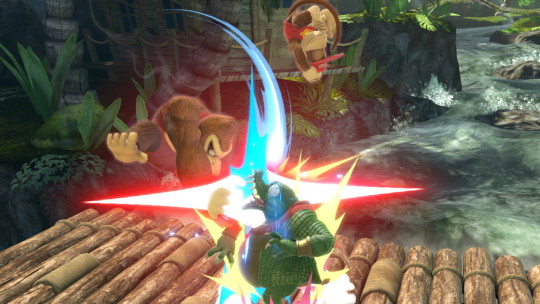
Why this game?
Donkey Kong is known best as a character who is typically one of the most powerful in the games he’s in, including Smash Bros. Over the years he has had various games where he’s been playable, with his own series, Donkey Kong Country. What’s interesting with this series is that in the original three games DK himself was only playable in the very first, having been kidnapped by K Rool in the second and third games. He returned to being playable in DK64 where he was the first of 5 characters that were unlockable in the game being second only to Chunky Kong in strength. After Rareware, the developers of the Donkey Kong Country games and DK64 were sold to Microsoft, Nintendo came out with a new game, Donkey Kong Jungle Beat. In this game DK was probably the most violent and powerful he’d been shown in a platformer, with his moves often involving beating his enemies repeatedly with powerful attacks. After this and a long break, the Donkey Kong Country series finally returned in a game called fittingly Donkey Kong Country Returns, a new 2.5D platformer in which DK had to go across his island to reclaim his banana hoard again. This time however, he had to take it back from the Tiki Tak Tribe rather than the Kremlings as in the original series. This game managed to make DK feel more powerful as he did in Jungle Beat but also keep the same platforming style of the original games with one of the most notable features being how the environments DK would travel through would often change based on his actions, with him smashing his way through various locations.
So, with many of the later games focusing more on DK’s power, why did I choose Donkey Kong Country rather than the later games to represent DK? Well, simply put because those games all build off of the foundation Donkey Kong Country set down. Before Donkey Kong Country, DK had only appeared in games where he was an enemy of Mario or in one case a pest exterminator called Stanley. With a remake of the original arcade game on Gameboy having come out within the same year, only a few months before DKC, it’s easy to compare the two to see just how different the original DK was to the one who’s used today. Donkey Kong in this new game was made into a new character from the original, with the original now becoming Cranky Kong, a grouchy old ape past his prime. Donkey Kong Country introduced DK’s new home of DK Island, a new cast who helped him on his adventure along with a new set of enemies in the Kremlings and their leader King K Rool. DK’s design was also changed, one which has stuck pretty much to this day with the odd sort of hairstyle the fur on his head makes. It’s for this reason I feel when looking at DK’s origins, this game is the best place to start, as it was the game that essentially redefined DK into the form he has to this day.
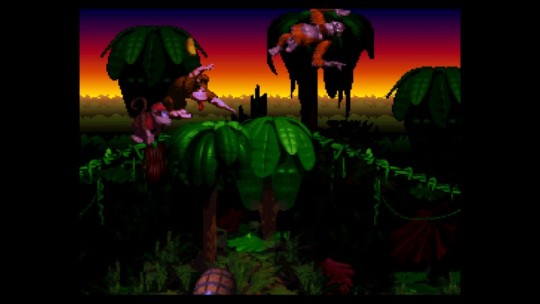
My past with this game.
This game and series as a whole are very important to me and a huge part of my gaming history. This series along with Mario were the games I grew up with, with this and Super Mario Bros 3 I believe being probably the first videogames I ever played. As such, I admit to having a massive nostalgia bias to the series, however, I still to this day feel this is a fantastic game, amongst some of my personal favourite games of all time. This game specifically isn’t my favourite of the series. In comparison to the other two Donkey Kong Country games, this game was shorter with less secrets, such as the secret worlds and secret final bosses the other two games had to offer. However, I definitely wouldn’t pass it up in favour of the other two games and I have enjoyed replaying it many times over the years. One aspect I have fond memories of personally is that this was one of the few games my parents would play with me, with my Dad in particular being a big fan of it. It was probably one of the only games where I had the experience of starting off being far worse at the game than my Father but gradually getting better until finally, I could beat the game, something he’d not been able to do. As such I suppose I could consider this game as sort of a benchmark for me with regards to finally starting to actually finish games. I have other personal memories from my childhood relating to this game, such as only really being able to play when my parents would allow me to set up the SNES as I was around 4-5 years old and having my Cousins over to play the game with me, but I don’t feel going into that much more would really add a lot to this.
With regards to the gameplay itself etc, the game was fairly simple to the point I could play it as my first game, but even now there are definitely a fair few challenges later down the line, granted nothing on the level of other games around at the time and earlier that I’d never played such as Megaman and Castlevania, but definitely parts that I had to play a lot of times to get past. I remember one specific stage I had trouble with to the point that I actually asked my parents if I could phone the Nintendo Helpline. The level in question was Slipslide Ride, a level where there were ropes you would climb, with the purple ones constantly sliding you down and the blue ones constantly sliding you up. The part I got stuck on was where the only option to proceed was to climb up two purple ropes, however trying to climb up wouldn’t work due to the constant slipping with you only at best being able to stay in place. I remember when I managed to get through on the Nintendo Helpline the operator on the other end gave me the solution, which was to jump between the two purple ropes which would let you gradually get higher until you could jump off them onto the platform above. So what’s the moral of the story? Well, I’d say it’s that I’ve always been a stinky cheater even before looking up solutions on the internet was a thing. Although really, I’m only mentioning this because I find it sort of an interesting example of one of the possible ways to get help with games before you could just look up a walkthrough on the internet. Of course, I believe book guides and game magazines were probably around at the time that I could have used, but being a fairly young kid then and not really seeing many other kids beyond my Cousins sometimes meant that I wasn’t really aware of most of these options. I forget now if the Nintendo Helpline was meant to be one for people with actual issues with their systems or games etc or was advertised as a service for help with “game tips” also, either way I was probably one of those kids who would lead to Nintendo’s attempts to put help features into games down the line, i.e. a true hero.
Something not particularly good for the subject of this post, Donkey Kong himself is he tended to be shown up in this game by his new friend Diddy, with his only real advantage being he could defeat a specific enemy Diddy couldn’t. DK could defeat Krusha a muscle-bound Kremling, and could defeat two other enemies Diddy couldn’t as easily, being Klump a Kremling with a hardhat that Diddy had to cartwheel into, and Army an Armadillo who Diddy would have to jump on once to bring him out of his ball form and then jump on again to defeat. DK could defeat both of these enemies with just a single jump. Diddy on the other hand, would move faster and was nimbler with his jumps, although DK could still manage to jump as far as was needed in the game, everyone I knew who played the game would always prefer to keep Diddy in reserve when playing. This brings me onto another aspect that at the time and even now I quite liked about the game, how the Kongs would team up. Instead of playing through stages as either DK or Diddy alone, you would play as one of the Kongs with the other following you. When you got hit by an enemy, the Kong who was hit would run away and you’d take control of the Kong who was following. The Kong who was following you wouldn’t be able to do anything, being more of a ghost really in actual gameplay, just following you along not being affected by enemies or obstacles. This I feel really added to the atmosphere of the game as you didn’t feel as alone as in other games unless you’d lost one of the Kongs, and with DK and Diddy often being on-screen together it helped make them feel more of a duo than other game characters at the time such as Mario and Luigi, who in most of their games then would take turns going through levels on their own rather than together. The game also did a good job of avoiding the screen becoming too cluttered or confusing the Kong you were controlling for the one you weren’t by making the one following have a slightly more faded look, making it easier to focus on the character you were specifically controlling at the time. In order to bring back one of the Kongs you’d lost when you were down to just one you would have to find a DK barrel to break them out of, which you might recognise in Smash as being DK and Diddy’s entrance animation.
Atmosphere is probably why this game has always been so nostalgic to me. I’ve never cared overly much for graphics (although I definitely can appreciate when something looks good) and whilst this game at the time was fairly breath-taking graphically, the music and the art style were probably the bigger aspect of why I loved the game, with me often as a kid enjoying drawing all the different characters and enemies and reading the instruction manual to look at the various artwork in it. The series would get even better from here, but there are a lot of visual aspects unique to this game that stand out even now. Probably one of the most cited examples at the time was in the very first stage where just before you reached the end of it the sun would set and the place would turn from day to night. It’s hard really to describe atmosphere much more as it’s something you get just from playing or seeing the game itself, so I think it’s best to leave it at saying simply I’ve always liked it in this game.
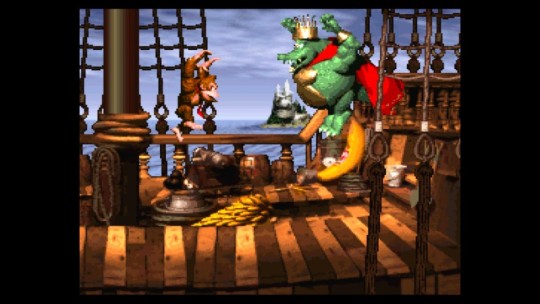
My Smash Playthrough.
As I’ve stated before, this is a game I’ve played through a few times before, and I was looking forward to doing so again. Although this is the second post I’m making, at the time this was probably the fifth game I played roughly. The reason why is that I made this list before Smash Bros Ultimate was announced and gave an order to the fighters, so rather than having DK as fighter 2 I had the characters more often shown in various trailers, such as the first trailer for Smash Wii U with Mario, Link, Kirby and Pikachu as the first ones on my list. It was due to this therefore I was on a roll and moved pretty quickly onto this game seeing as the previous game I’d played for Kirby wasn’t very long or difficult. Replaying this game from what I remember I didn’t run into many problems and it was overall the same fun experience I’ve always found it to be replaying it.
So when it comes to remembering this run again as it was some time ago there aren’t many things that stick out in my mind. Stages I remember having issues with were mostly ones I’ve always found difficult, and I think most people do. One of them, Tanked up Trouble was a level I’d always found irritating as you are on a platform with five lights on it which gradually go out. You have to collect fuel barrels in order to bring the lights back on, and if the lights all go out the platform would fall with you on it. Of course, you also had to stay on the moving platform the whole time or else you would fall off the stage, and enemies would be waiting to block your way requiring you to either avoid them or jump on them if you could all while not losing track of and landing back on the platform. I believe overall I didn’t find this level as difficult as I had in the past, although I definitely had a couple of deaths on it. Probably the hardest level overall was Platform Perils, the final regular level in the game which has you jumping between various small moving platforms. The biggest issue on this stage however was the grey Krushas, exclusive to this stage. These variations of Krusha enemies were strong enough that even DK couldn’t beat them by jumping on them, requiring a barrel to be thrown at them as the only way of defeating them. Due to this, often the stage would require you to carry a barrel on small moving platforms and not drop or accidentally break it before you reached the Krusha who is on another small platform you need to get onto. If you lost the barrel there was no way to defeat the Krusha meaning you’d end up dying and having to try the level again. This level took me many attempts I remember and was probably the biggest challenge I had, but eventually I beat it, leading on to me beating the final bosses not too much longer after.
When replaying this game, I’ll admit there was one negative that stood out to me more now than I remember when playing it as a kid, which is objects in the foreground. I think this is more a problem I’ve found myself than one that many people commonly find, but I’d sometimes find myself getting irritated in stages where there would be decorations in the foreground that go past. I would not find them big enough to actually block the view of gameplay, but moving quickly through a stage and having them go by would on some occasions be something I’d find irritating to look at, with some examples being the stalactites and stalagmites in the cave levels that would appear in the foreground as you went along. Another irritating visual effect I’ve found is the blizzard effect in the snow stages. The point of it of course is to make it more difficult to see, however I would find it somewhat taxing on my eyes at times, and with the stages often requiring either precise jumping on platforms or timing when to blast from one barrel cannon to another it could get very irritating. One improvement I’d say in the virtual console release is the removal of a specific effect in the stage Torchlight Trouble. In this stage you are going through a dark cave and require Squawks the Parrot to follow you with a torchlight so you could see where you’re going. In the original version of the game, every time you’d turn Squawks would turn and shine the torchlight directly at the screen creating a bright flash for a fraction of a second. This would happen every time you turned and I remember finding it could be very irritating, so I was glad to see the Virtual Console release had gotten rid of the flash.
The bosses are fairly average when it comes down to it, and out of the three games in the series probably the least interesting. This isn’t helped by two of them being basically recoloured harder versions of earlier bosses later in the game, although this game was hardly the first to do this. This does get a funny reference in the GBA remake of this game where Cranky Kong will appear to talk with DK after each boss, and on the first recolour boss he appears to basically complain about how lazy the designers are just reusing an earlier boss. Probably one of the few aspects of the remakes I liked. Most of the bosses simply require you to jump on them when you get the chance, with the others requiring you either to simply avoid them and kill the enemies they spawn, or throw barrels at them when they’re not invincible. The bosses consist of larger versions of regular enemies such as the giant beaver Very Gnawty which is a bigger version of the regular Gnawty enemies. The final boss King K Rool however is easily the best boss in the game. He’s fairly challenging and has a lot of fun attacks. I don’t want to spoil too much of the boss fight against him as a lot of it relates to his portrayal in Smash so I will simply say he makes a great conclusion to the game.
The game’s ending isn’t particularly special, but of course personally it holds a lot of nostalgia for me, especially being one of the first ever endings I actually got to in a game. The music for it is a really nice ending track and it has a nice cast call with every character, enemy and boss in the game walking through DK’s Treehouse with their name being displayed below. I tend to like these endings in games as it’s a fun recap of what you’ve gone through in the game. I didn’t 100% (or as this is a Rareware game 101%) the game, mostly as the only real reward is Cranky Kong’s dialogue changes from saying ‘if I’d been playing I’d have found everything’ to congratulating you. Also, I tend to leave some things in the games I’ve been playing through so I have something that if I feel like coming back to the game later down the line I can still do. Overall, despite the few complaints I brought up, this is still an amazing game and one that will always be very important to me personally which I enjoyed playing through again.
Specific aspects about the game relating to Donkey Kong in Smash.
Donkey Kong is another character who doesn’t really have equipment he uses in the game, nor any really customisable aspects. Unlike Mario in Super Mario 64 however, he also doesn’t have a lot of moves he really draws from this game. The only moves he has in Smash Bros that come from this game specifically are his forward roll, which was added in his later Smash Bros appearances, and his Hand Slap move. This move involves DK slapping the ground with his hands, often defeating enemies who are right in front of him when he does it, producing a single banana when they’re defeated and being usable sometimes to find hidden items in the floor. It is fairly difficult to use on enemies not having a very far reach and is fairly slow making it not very useful, especially in comparison to just jumping on or rolling into enemies. Later games such as Donkey Kong Country Returns and Tropical Freeze would make this ability far more powerful and useful, but this is where it originated and as such is what the move in Smash Bros is based on. One final aspect from this game that DK uses in Smash Bros is his ability to lift barrels and move around with them. In Smash Bros DK was one of the only characters in the original game who could lift heavy objects such as barrels and walk around with them. Later games would have other big characters such as Bowser also be able to do this, however DK has another ability unique to him. When grabbing another character, DK can lift them similar to how he lifts heavy objects such as barrels and he can carry them around before throwing them or they escape from his grasp, which is most likely based on his carrying abilities with barrels in this game. The only other thing of note which I mentioned earlier is DK’s stage entrance involves him breaking out of a DK barrel, similarly to how he will be trapped in one when playing as Diddy alone in this game and will have to be broken out of it.
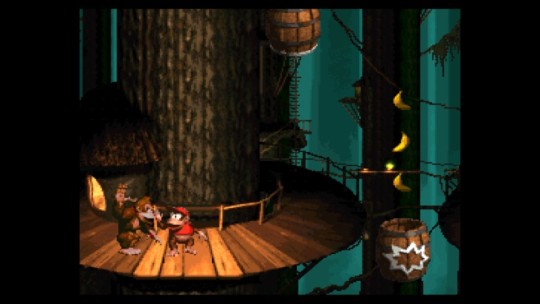
Credits.
Information such as release dates were found through Super Mario Wiki and Donkey Kong Wiki.
Screenshots taken by me using Miiverse.
#Donkey Kong#DK#Donkey Kong Country#Super Smash Bros#SNES#Wii U#Virtual Console#My Smash Playthrough#My Smash Playthroughs
4 notes
·
View notes
Text
My top 10 least favorite bosses.
I love boss battles, they are a great way to challenge the player and to wrap up a level or a game. Not all bosses are made equal though, for every great boss there is a mediocre one as well. These bosses got on my bad side due to various reasons. Now, this list is subjective and my opinion, not every boss on this list is terrible from a design standpoint, and there may even be some on this list you may not agree with. This is fine, your free to have your favorites or least favorites. In fact, I would love to see your least favorite bosses in the comments if you would please. Secondly, no bosses from my top 50 list will be on this list. This is to avoid redundancy. Lets take a look at some of my least favorite bosses.
NUMBER 10 - Xande (Final Fantasy 3)

This just goes to show that not every boss on this list is bad. On a purely technical note, Xande is a perfectly fine boss, however to describe this foe in one word would be “disappointment”. Xande is built up as the ultimate bad guy in Final Fantasy III. His magic literally tearing the world apart and just causing havoc. He is so strong that approaching his tower before it is time results in a game over. He seems to be almighty, or so you would believe. After conquering one of the longest and most difficult dungeons in one of the hardest numbered Final Fantasy games, Xande is just lackluster. He is an incredibly basic magic oriented boss with lukewarm stats, he is barely threatening. His death introduces the true final boss so he just serves as a Segway to the cloud of darkness. Despite being the primary antagonist of Final Fantasy III, he isn’t even given a spot in the dissidia roster. Talk about a let down.
How this boss could have been better – Beef him up to final boss status and just get rid of the could of darkness.
**********
NUMBER 9 - Ghost of Lady Comstock (Bioshock Infinite)

This boss is an infamous one for sure. I am one of those people who was disappointed by Bioshock Infinite. It was a great game but it just lacked the special atmosphere that made Bioshock 1 great for me. Enemies felt more bland and uninspired, and the ghost of lady Comstock is a boring boss to take down. The battle drags on forever with the ghost just teleporting around and constantly reviving fallen enemies to fight alongside her. She is fought several times and each time she is just annoying. She can take a lot of punishment and it is hard to break her out of reviving everyone you just defeated. Whats worse is that my game crashed the first time I beat her, causing me to have to fight her twice, then the second time my power went out! I fought this boss more times than necessary…and I didn’t like it at all.
How this boss could have been better – If it weren’t so long…
**********
NUMBER 8 – Final boss (Ninja Gaiden II)
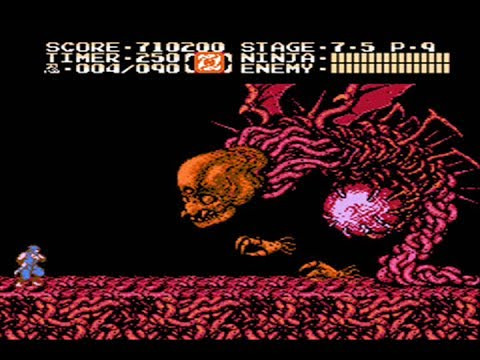
There are a number of bad NES era bosses. Though I cannot necessarily say its totally unforgivable, because of the era there was no norm, no bar that was set when it came to boss quality. Though, what is bad is when you take a pre-existing boss that was fine and make it worse. The final boss of Ninja Gaiden II for the NES is a three part endurance test. The first form is a humanoid enemy that floats around shooting tons of fireballs and is a general nuisance to hit. The second form is a large room with a ceiling that drips dangerous liquid and a giant head that shoots lasers, this part is tough and can drain health fast. Stage three is essentially a repeat of the final boss of the first game, now with hands. After destroying its head, you must destroy its core while it shoots attacks everywhere. What makes this so bad? YOU NEED TO DO THIS WITH ONLY ONE HEALTH BAR! If you die, you need to redo the final stage, its unnecessarily punishing.
How this boss could have been better – If it either restored health between stages or allowed you to restart from the beginning of the fight.
**********
NUMBER 7 - Krauser QTE fight (Resident Evil 4)

Ill keep this one brief because most gamers know about this fight. Resident Evil 4 is an action horror game with occasional quick time events. Up until this point these events were for either outrunning boulders or avoiding enemy attacks during fights. This fight occurs during a cutscene and comes out of virtually nowhere. The window of time to react is very small and a single error will cause you to have to restart the cutscene. Its just so out of place and unnecessary…
How this boss could have been better – It could have been an actual fight…
**********
NUMBER 6 - Alpha 152 (Dead or Alive 4)
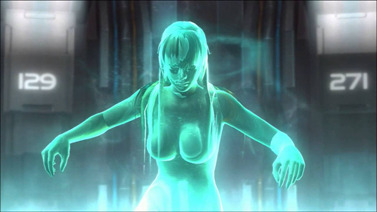
Fighting game bosses can be some of the most unfair and frustrating things a gamer has to overcome. While the majority of final bosses from fighting games could make this list, I decided to pick Alpha 152 from DOA4. Alpha is a clone of Hitmone, but her moveset is unique. She can turn the battle on its head at any moment and cut your health down to nothing in one massive combo. She is fast, she is aggressive, she can counter most attacks and she can teleport. The combos I mentioned are insanely long and hard to avoid. She serves as the final boss for most characters story mode, in story mode she isn’t as bad. In arcade mode however, she is a nightmare, her aggression is through the roof and she must be defeated twice in order to win! This boss is frustrating to fight and can be downright unfair at times. Nothing stings worse in DOA4 than having her down at 10% health while you have high health, only to be destroyed by her.
How this boss could have been better – If her combos were toned down just a bit.
**********
NUMBER 5 - Doc Robot (Mega Man 3)
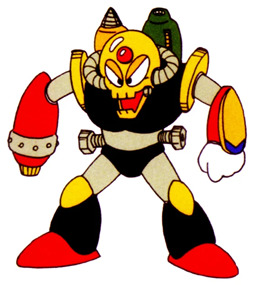
Doc robot is perhaps the most unnecessary boss of all time. This dude is a cheap gimmick made to try to expand the run time of Mega Man 3. You have to fight him 8 times, 8 times! Each time he gets a new gimmick stolen from the Mega Man 2 robot masters and uses them in a far more annoying way. He tends to just hover over you to deal continuous damage, which is something I really do not like. This boss is just pointless padding and gives no reward to be beaten. I don’t like this boss because he is annoying and overstays his welcome.
How this boss could have been better – If he were encountered once, but used multiple boss attacks, it would have been much more memorable and tolerable.
**********
NUMBER 4 - Gyorg (Majora's Mask)

This is referring to the N64 version of Gyorg, because the 3DS version is substantially better. Gyorg is the worst boss of the worst temple in Majora’s Mask. A giant shark like monster that swims around a platform that Link is standing one. While on the platform, the beast will try to knock Link into the water, so they can eat him. In order to beat Gyorg, you have to use the Zora mask and fight it underwater, occasionally stunning it to hit it. Here lies the problem, your underwater so your dealing with those kind of controls. The second problem is that Gyorg recovers to quickly and the camera tends to shift away from them when you try to escape, often meaning you get eaten. So basically the camera ruins this boss and makes it a total chore to fight. I had to restart the great bay temple at least 3 times because I ran out of time trying to beat this thing on my first run of Majora’s Mask oh so many years ago…
How this boss could have been better – It actually is better in the 3DS remake, Nintendo learned from their mistakes.
**********
NUMBER 3 -Elana The squalid Queen (Dark Souls 2)

This boss was perhaps the most sour point of the Crown of the Sunken king dlc. To make a long story short, shes a shard of a great evil named Manus and is probably responsible for the downfall of her kingdom. Shes essentially the main antagonist of the DLC even though she is overshadowed by the Dragon. The first gripe with her is the fact that, unless you know where a secret bonfire is, dieing to her will send you back far. She fights similar to the final boss, but has a knack for teleporting around and using magic attacks when your not looking. This isn’t so bad, but she has a lot of health, does a lot of damage and summons help. The summoning is why I hate this boss, she summons enemies that can inflict toxic. She can summon skeletons, which is not so bad, but she can also summon another boss that can tear you apart. This boss is badly designed and is one of the bosses that made me legit angry. I was extremely relieved when I finally bested her, only to meet a dragon face to face literally a minute after.
How this boss could have been better – Just get rid of her summoning ability, its just not fair having her summon another boss.
**********
NUMBER 2 - Sir Arthur (Sonic and the Black Knight)

King Arthur is the primary antagonist for the majority of the mediocre Sonic and the Black Knight. His presence is virtually none-existent until the boss fight. He fights you on horseback and spends most of the fight running away and pestering you with magic and warping swords. If he gets enough distance he will turn around and charge. All of his attacks are annoying but not very hard to dodge or avoid. So why is he this high on the list? Three words… Quick Time Event. In order to damage him you have to swing the wii mote to parry him. The timing is almost inhumanly precise and more often than not it doesn’t matter if you do is spot on, you will fail. If you beat the game you know which QTE in particular makes this boss horrible. If you don’t, watch the game grumps play through, because it shows this boss’ absurdity at its greatest. This boss is for me the worst sonic boss yet.
How this boss could have been better – If the quick time event was removed, this boss would be off the list. Though even then it would still be a very mediocre boss.
**********
NUMBER 1 - Clyde's Machine (Pac Man World 2)

This is a boss I despise. Clyde’s machine is the third ghost robot boss and the fourth boss of Pac-Man World 2. These bosses can only be damaged by jumping on their heads, usually this isn’t to hard of a task, but Clyde ups the difficulty to 11. On an uneven platform surrounded by lava, a single misstep will result in a dead Pac-Man. And boy oh boy, how often that happens. Pac Man seems to just want to take a lava bath! You stand still, you die because one of his attacks pushed you in the lava. You move? You die because you fell into the lava. You stay in the middle of the platform? Isnt it wonderful how all his attacks just hit you head on when you do that? You try to rev roll? Hello Lava my old friend… The worst part is that even attacking him might send you flying into the pit for no reason. The only saving grace is that this boss has checkpoints…
How this boss could have been better – If it didn’t exist.
**********
Thank you for reading my list! What bosses got under your skin? Feel free to share in the comments! Next time we will be taking a more positive turn to look at my top 10 favorite grass type Pokemon, see you then, ciao!
#final fantasy#bioshock#ninja gaiden#resident evil#dead or alive#doa#mega man#the legend of zelda#majora's mask#Dark Souls#top 10#list#boss battle#boss#gaming#video games#sonic#sonic and the black knight#pac man
4 notes
·
View notes
Text
Yakking ‘bout Games: Resident Evil 4

Yakking ‘bout Games is a series where I talk about games that I’m currently playing or have just finished. It can be new or old, console or PC, good or bad, it really doesn’t matter. If it’s a game worth talking about, you’ll see it covered here.
Where do I even start with this one? Resident Evil 4 is one of those games that doesn’t really need an introduction. It’s a legend of the industry. A game that somehow managed to transcend its own genre to reinvent another. I could start with how it was supposed to be a more traditional entry in the series. I could discuss about it being part of the Capcom Five, a series of titles intended to be exclusive to the Nintendo GameCube which ended in complete disaster. I think it would be easier to just dive in, wouldn’t you agree?

Fair enough, Leon. We’re getting into it now.
After the Spencer Mansion (RE1) and Raccoon City (RE2 & RE3) incidents, the evil pharmaceutical organisation known as Umbrella are finished. All is right with the world. It doesn’t last long however as Ashley Graham (the US President’s daughter) is kidnapped and only one man is up to the job: former rookie cop turned badass secret agent, Leon S. Kennedy. Leon is sent to rural Spain to locate and secure Ashley, but it isn’t long before things go pear-shaped and Leon ends up being infected with a mysterious parasite.
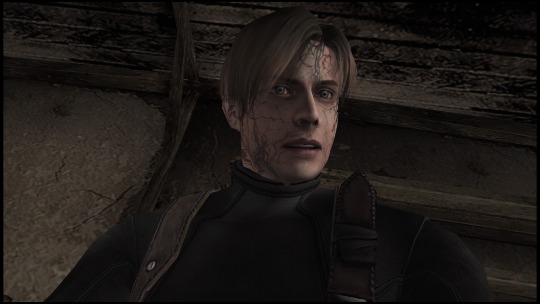
To be fair, when have rescue missions ever gone smoothly in movies and video games?
I wouldn’t say the story in RE4 is the most complex or well delivered, but the dialogue and characters certainly hold it up. I’m convinced that the writers just sat around watching Commando when coming up with the dialogue for this. Some of Leon’s lines feel right at home in that style of movie and I love them. A personal favourite of mine would have to be his exclaimation of “No thanks, bro!” when first encountering one of the villains. The characters are also a delight. I adored Luis Sera, a very charming womaniser, Ada Wong, a femme fetale type returning from Resident Evil 2 and Lord Saddler, the grandiose leader of the evil cult that kidnapped Ashley. Of course I can’t forget The Merchant as well.

You’re imagining his voice right now, aren’t you? Me too.
To say that RE4 is just a survival horror game is overlooking what this game managed to achieve with its gameplay. It still keeps with its survival horror roots in that inventory and resource management is a key element. You don’t have a huge amount of inventory space at the start (though this can be upgraded) so you can only hold a certain amount of weapons, ammo and healing items. Meaning that you have be a bit smart with whatever you have. You can even play a little inventory Tetris to fit items in. You still solve puzzles and still have to hunt for key items in order to progress but what truly made this game stand out from the crowd was its take on third-person shooting.
Resident Evil 4 finally managed to crack the problem that so many third-person shooters and action games could not figure out. It managed to fix the camera perspective by having the camera always overlooking the main character’s shoulder even when aiming. This was a literal game changer. It finally allowed for more precision and less frustration which wasn’t possible before. It feels great. Firing a gun in this game is a treat. All the weapons feel fantastic to use (especially the shotguns) and as mentioned previously, the over-the-shoulder perspective allows for more precise aiming so you can shoot enemies in certain body parts which plays a huge role as certain enemies and bosses can only be defeated this way. Instead of a reticule, you get a laser sight on all guns which adds a little difficulty to the aiming.
The melee combat also gets an upgrade. It was pretty simplistic in the previous entries as it was supposed to be more of a fall back option if you used up all of your ammo. You still get a knife in this game which can be drawn to give enemies a quick slash which is useful if they’re downed, but you can also perform melee moves after staggering an enemy with a well-placed shot. These are pretty fun to pull off and can be instrumental in saving your life. The combat just feels fantastic and this game introduces so many different ways to deal with certain situations. Guns can even be upgraded in order to be even more effective with them dealing better firepower and higher ammo capacity.
There are problems with the gameplay for sure. It’s not too long before you encounter Ashley and have her tag along with you for a decent chunk of the game. Now generally Ashley isn’t too problematic to have around. You can tell her to follow you, hold position and even have her hide in certain spots and generally she follows these orders to the letter. The problem lies with her AI just deciding to do some daft things from time to time. I had numerous instances where she would stop following me while we were escaping from some enemies and would just cower allowing the enemy to grab and take her away. Thus the ever grating “LEON!!!” screech begins (no offense to her voice actress.) I feel that Silent Hill 4 did the whole escort thing better. Eileen Galvin wouldn’t do anything crazy (unless you gave her a weapon.)

She’s not best pleased with me after that last paragraph. I don’t blame her.
Then we have the Quick Time Events. Now generally I don’t have a problem with QTEs being in games. It’s a regular thing in games now, I can live with it. The ones in RE4 at times can feel a little cheap. Especially the ones that just pop up out of nowhere during a cutscene when you least expect it. Not cool, Capcom. Not cool.
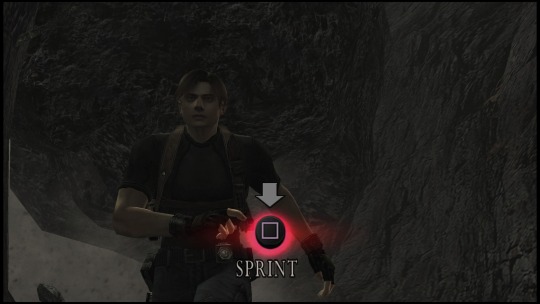
I bet Indiana Jones didn’t have to worry about pressing square to run away...
Another issue I have is that some of the boss fights in this game do a pretty poor job of telling the player if their attacks are having any effect. It feels like you have to dump half your resources before they even flinch. This is a problem I’ve had with most of the games in this series and it still happens in the recent ones. It’s just not as bad. For the record, I’m not saying that the boss fights are near impossible, I’m just saying that I wish that certain bosses gave better indication that they’re being hurt by my attacks.
Resident Evil 4′s presentation is still excellent to this day. Obviously the graphics are showing their age (even more so when blown up to HD), but the enviroments are still striking and carry a great sense of atmosphere. I especially loved the look of the castle sections of the game. It definitely gave me a bit of a Devil May Cry vibe. (Makes sense. The two series are very much linked.)

Definitely gets the “S” for Stylish.
The cutscenes look good and are pretty well directed. The voice acting is really good considering when this came out. Plus I couldn’t fault the music and sound design if I tried. It’s always been an area where this series has excelled at.
The game has a very good length to it. I finished it in about 10-11 hours. There is reason to go back again since you unlock some weapons and costumes just for finishing the game. There is also the Separate Ways and Assignment Ada chapters (available on every platform except the OG GameCube version) which focus on Ada Wong and they add a good few more hours to the play time. Plus you have the highly replayable arcade-style Mercenaries mode which tasks you with killing as many enemies as you can within a time limit to earn the highest score possible.
Resident Evil 4 is just sublime. The combat still packs a punch even to this day. It feels amazing and it allows you to approach different situations in a variety of ways. The game also just manages to stay true to the traditional fixed camera angle survival horror entries that came before by sticking to the same core values that made those games so tense and engaging. It may have some elements that haven’t aged fantastically, but it still plays well and provides a great experience for any budding survival horror fan. It’s a shame that because of this game, the series went off the rails for a while as some of the next entries just focused on the action. (For the record, I liked Resi 5 a lot.)
Interestingly enough, Resident Evil 4 doesn’t really get any of the stigma that comes with that fact. It’s still beloved and important. Play it yourself sometime and you’ll understand why.
0 notes
Photo
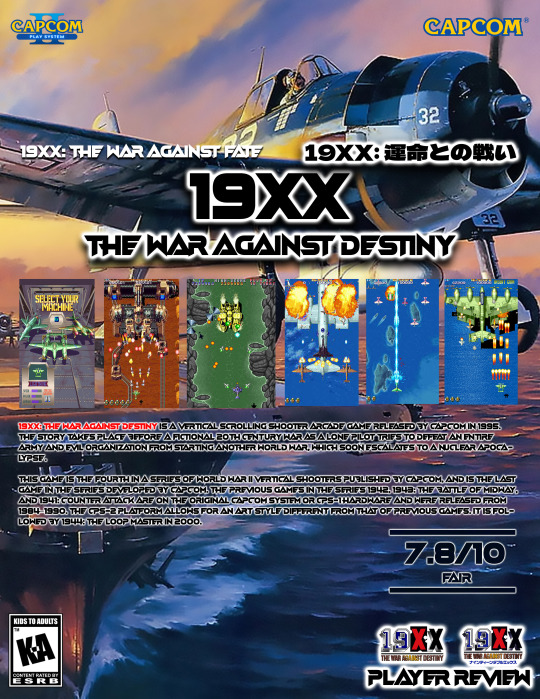
Player Review-19XX: The War Against Destiny (1995) Developers-Capcom Publishers-Capcom Designers-Shinichiro Obata, Tomonori Nonaka, Yoichiro Ikeda Programmers-Hideo Sako, Tatsumi Kimoto, Tomohiro Ueno Artists-Eizi Murabayashi, Gorō Suzuki, Hiroshi Sugiyama Composers-Shun Nishigaki, Tatsuro Suzuki Series-194X Platforms-Arcade Genres-Vertically Scrolling Shooter Modes-Single-Player, Co-op Arcade system-CP System II
19XX: War Against Destiny is actually the first game I played in the 19XX series. It's not THE best nor is it the last game in the series, which makes no sense because 1944 actually follows this. You would think that the out-of-context game in the series that doesn't specify when exactly it takes place would be either the first or final, but this is the route they went. While this game is a massive step up from the previous 3, it's still a pretty generic experience overall.
What I DO like about 19XX as opposed to the other games in the series is that you can pick between 3 different machines with their own unique capabilities. A sense of variety is something that has always been missing. Like 1944, it does a great job of selling you on this atmosphere through the soundtrack, the effects, and the art direction. I like the "mission briefing" style cinematic they show before each level because it really adds to the aesthetic they were going for. Although the setting still seems to be World War II (though that isn't specified), they have gotten a lot more creative with the enemy types. We know that none of the Axis Powers had massive 4-legged tanks but in the context of a video game it's nice to see the creators step outside the box.
Despite the disclaimer at the beginning of the game that explains that none of the events that take place are true and it's all fiction, there still isn't much of a story here. If you play the game to the ending, it DOES have one but there's nothing substantial. I assume that the disclaimer is just there so that people don't think anything that happens during gameplay actually happened in any World War.
THE GOOD -I like being able to pick a different playable machine because it adds a sense of a variety to a game that isn't present in other games in the series.
-The developers flexed their creativity a little bit with the designs of the enemy machines instead of just having you destroy a bunch of generic bombers, warships & tanks. -Nice mellow soundtrack, not better or worse than what you get in 1944...just something different but that still fits the game's overall style.
THE BAD -Even with all the power-ups and charge shots and bombs that you're allowed it still seems like some enemies are unkillable. You will pour so much time into taking down some of the bosses.
I give this game a 7.8 out of 10 FAIR
#19XX: The War Against Destiny#19XX#194X#Arcade#Vertical-Scrolling Shooter#CPS-2#Capcom Play System II#Capcom#World War II#1995#Axis Powers
1 note
·
View note
Text
New Xbox One Games for March 11 to 13

New Xbox One Games for March 11 to 13.
Ori and the Will of the Wisps (March 11)
The little spirit Ori is no stranger to peril, but when a fateful flight puts the owlet Ku in harm’s way, it will take more than bravery to bring a family back together, heal a broken land, and discover Ori’s true destiny. From the creators of the acclaimed action-platformer Ori and the Blind Forest comes the highly anticipated sequel. Embark on an all-new adventure in a vast world filled with new friends and foes that come to life in stunning, hand-painted artwork. Set to a fully orchestrated original score, Ori and the Will of the Wisps continues the Moon Studios tradition of tightly crafted platforming action and deeply emotional storytelling. Features: Strikingly beautiful environment - Explore a vast, exotic, and breathtaking world in 4K and HDR on Xbox One X and Windows 10.Emotional and engaging story - Unravel Ori’s true destiny in this hand-crafted story driven adventure with a stunning soundtrack.New weapons and attacks - Wield new spirit weapons, spells and skills offering new dynamic combat mechanics to the world of Ori.All-new shard system - Power-up Ori’s newfound abilities and customize your style of play.Larger-than-life bosses - Encounter towering enemies and thrilling escape sequences.New characters - Seek help from an expansive cast of new characters who will help you uncover Ori’s mysterious fate.Spirit Trials - Race to the top of the leaderboards in unique speed-run challenges throughout the game. https://youtu.be/2kPSl2vyu2Y
Super Destronaut: Land Wars (March 11)
It’s time for a new point of view to the classic arcade shooter experience! In Super Destronaut Land Wars, it’s up to you take shoot down enemies and collect points to move on to the next level! Inspired by arcade classics, this new arcade experience mixes a first-person viewpoint with classic invader style shooting. Together, this unique mashup will test your skills across 30 different challenges! For a change of pace try arcade mode which mixes different playstyles like combo breaker and snail mode!
Hidden Through Time (March 12)
Hidden Through Time is a cute game of hide and seek with objects scattered through the wonderful history of our world. Use cryptic hints to discover every secret as you explore the colourful hand drawn levels Find enough objects to advance to the next stage, and make your way through all four great ages. Still desire more or wish to unleash your creativity? Our editor is available to anyone, allowing you to create your very own levels and share them on our cloud! Here you can also discover, play and rate levels made by other creators from all around the world! So join Clicky on his wondrous adventure in Hidden Through Time! https://youtu.be/BEx6zHEH_bI
Bless Unleashed (March 12)
Get a head start and be one of the first to leap into the world of Lumios with the Bless Unleashed: Deluxe Founder's Pack! This Founder's Pack unlocks 7 days of head start access before launch, an exclusive Founder's title, a unique mount, and more!
Neon City Riders (March 12)
Looking for a a 2D action-adventure mixed with super-powered urban gangs in a post-cyberpunk neon scenario? Well, if you do, Neon City Riders is right for you! Take on the role of Rick, a masked vigilante who needs to explore the decaying futuristic Neon City in search of items, superpowers and companions to free the turfs from the four super-powered gangs claws'! Features: Make your way into the depths of each turf while attacking, dashing and parrying waves of vicious gang membersExplore at your own phase the open-ended map of the Neon City's turfs in the order that suits youUnlock super-powers to enhance your strength and reach new areasUse all your abilities to complete puzzles and open new routes in your mapImmerse in the multi-ending story through the cinema displays and the dialogs of the more than 100 Neon City inhabitantsRecruit useful partners to obtain improvements in your adventureFight against challenging bosses and show them who is the hero!Help the city inhabitants to complete the side-quests and obtain special itemsEnjoy the original soundtrack inspired in the 80's and 90's video game consoles https://youtu.be/BaZeYgsvqps
Pikuniku (March 12)
An absurdly wonderful puzzle-exploration game that takes place in a strange but playful world where not everything is as happy as it seems. Help peculiar characters overcome struggles, uncover a deep state conspiracy and start a fun little revolution in this delightful dystopian adventure.
State of Decay 2 – Juggernaut Edition (March 13)
State of Decay 2 is an open-world survival-fantasy game for you and up to 3 co-op friends. After a zombie apocalypse, your small group of survivors seek to rebuild a small corner of civilization, and you get to make all the decisions about how that happens. This remaster is packed full of new updates and experiences, like an improved tutorial experience, new open world logging town of Providence Ridge, new heavy melee weapons, spin off original content and access to all three add-on packs released to-date plus cross-platform multiplayer and more!
Roundguard (March 13)
Castle Springbottom is under attack and it’s up to the Roundguard to save the king and — more importantly — recover his gold! Roundguard is a bouncy dungeon crawler with pinball physics, lots of loot, and a randomized castle full of oddballs. Press your luck against hordes of dangerously cute monsters and challenging roguelike elements in this all-round bouncy adventure!
My Hero One’s Justice 2 (March 13)
The battle for justice continues, but this time the fight gets bigger, badder, and quirkier in My Hero One’s Justice 2. Based on the hit anime series, all your favorite characters return in this 3D arena fighter that pits heroes and villains in the ultimate test for righteousness. https://youtu.be/Pkgllk1_uo8
Mecho Tales (March 13)
An all-new adventure in the world of Mecho Wars! Run and shoot through chaotic platforming levels filled with spikes, bottomless pits and an army of deadly robots. Go it alone or team up with your friends in 4-player local multiplayer.
Ritual Crown of Horns (March 13)
Ritual: Crown of Horns is a slaughterhouse: a fast-paced action game set in an alternate Wild West, a demonic version of a hellish frontier. This arcade-inspired title unravels a tale about an unlikely duo: a bounty hunter who comes back from beyond the grave, yearning to exact revenge on his killers and a witch who aids him with a series of powerful rituals to further her own agenda. Push back hordes of enemies, while the witch performs her ritual. Use a whole arsenal to your advantage: mindfully swapping between weapons and spells. Unlock new tools and powerful items boosting your character. Travel throughout the Weird West picking your missions and planning future unlocks to finally exact your revenge! Ritual: Crown of Horns is a skill based game, where split-second decisions and planning on the go are more powerful than button mashing and throwing yourself mindlessly at enemies. https://youtu.be/GEIjKb9SgfE Read the full article
0 notes
Photo

Oni also known as Kuruoshiki Oni 狂オシキ鬼 Kuruoshiki Oni, “Mad Demon”, is a character in the Street Fighter series. He makes his debut in the Arcade Edition update of Super Street Fighter IV as a secret boss and a playable character. Oni is in fact Akuma, who has become one with the Satsui no Hado entirely.
Due to his training and meditation, Akuma may have suppressed some of the darker aspects of the Satsui no Hado, allowing him to control his actions. As Oni, he finally becomes one with the Satsui no Hado, whose power has now managed to completely overtake him.
According to Rose’s winquote to Oni, it can be presumed that he was meant to show up at a later time, but not during the present day. This gives the implication that Akuma becoming Oni is not a ‘what-if’ possibility, but Akuma’s fate.
The mysterious “shadow” that speaks to Akuma in his Super Street Fighter II Turbo Revival ending could be considered the first foreshadowing to Oni. The observation that Akuma makes about the Pandora Oni in Street Fighter X Tekken as a shadow could be a hint that this is the same being that spoke to him in that ending.
As seen in other media appearances (specifically Asura’s Wrath and UDON’s Super Street Fighter comics), Akuma appears to be able to transform into Oni and phase between those personas at will. Whether he can do this technique in the main games or not canonically is yet to be seen.
Oni appears as a far more muscular and noticeably larger version of Akuma. He has dark blue skin, glowing yellow-red eyes and glowing, spiky shoulder-length hair, fangs and short protrusions on his forehead, resembling growing horns. The top half of his gi has been blown off by the amount of dark ki he emanates, showing off his musculature; the prayer beads that were once around his neck now float about disconnected around his body. He also has claws on his fingers and toes, and no longer wears sandals; his voice also sounds much more demonic, akin to the demons of Asian myths.
When using fierce attacks or powerful physical attacks of any kind, his arms and legs glow a superheated color. While it is difficult to spot, the kanji of “heaven” also appears on his back during the same animations, seemingly having branded itself on his back. In his second alternate costume, his skin shows cracks like old plaster, which progressively fall away as he is hit with Focus Attacks, showing pure, swirling dark energy underneath; he is the only character to possess such a costume.
Most characters do not recognize Oni as a form of Akuma, even Akuma himself (although Oni recognizes Akuma as his former self). In fact, Zangief is the only fighter to notice Oni’s increased build mass; however, Zangief fails to notice any other changes (such as the blue skin, aura, etc.).
Oni has discarded his remaining humanity (saying that it is of no use to “evil incarnate”), his identity as Akuma, and his prominent moral code as a warrior; he will fight anyone to the death, regardless of condition, rather than seeking out worthy opponents to fight in a fair match. His presence is such that certain characters even refer to him as a god in their win quotes. In addition, he now talks in the third person more than usual, although sometimes he will talk in complete sentences. He also retains some of Akuma’s personality traits; despite calling himself “evil incarnate”, he still shows strong hostility towards villains such as Seth or M. Bison, who Akuma despises for taking “shortcuts” to attain their power. He is also visibly pleased to see Ryu give in to the Satsui no Hado, based on his pre-boss match dialogue with Evil Ryu.
As mentioned above, in Akuma’s Street Fighter X Tekken ending, he faces a Pandora version of Oni, which he aptly refers to as “nothing but a shadow, raging against that which casts it”; the Oni that came from Pandora’s box was Pandora’s energy responding to Akuma’s desire for a battle that will cost him his life.
In his intro of the Super Street Fighter IV, his roar echoes through the night. Instantly after, his presence causes the explosion of a nearby tree and the death of a bird. He then looks up and proclaims that he is “evil incarnate”.
In his ending, he stands in the center of a volcano. Then he only jumps up and chops the ground with his hand, resulting in an instant eruption that engulfs him in lava. As the lava explodes out of the volcano, Oni flies out of it unharmed, laughing maniacally and yelling ferociously.
Having reached the full extent of the Satsui no Hado to the point of turning into a demon, Oni’s style is considered “without”; instead of a concrete martial art style, he relies on unrestrained yet graceful movements filled with abandon, embodying that of a terrible destructive force beyond control. The Satsui no Hado also enables him to perform powerful energy attacks as well.
Strategy-wise, Oni is a character who retains the basic characteristics of Akuma, and has many more moves at his disposal which he can use to control the fight. Many of his special moves’ EX versions can confuse foes with their surprising speed, and his projectiles can be used to control space, while his midair moves can be used to keep an opponent off-balance.
His high-damage combos and reversal potential, combined with his above-average walk speed, allow players to create massive-pressure situations while remaining mobile and flexible via buffering moves into other attacks. Unfortunately, Oni’s below-average stamina and stun and his short-range Focus Attack means that he relies on getting up-close to the opponent to really excel, although he does have more than a few options for traveling across the screen quickly and closing in on his opponent.
Oni’s moves are naturally partially borrowed from Akuma (e.g. his heavy punch seems to resemble Akuma’s Focus Attack, although Oni performs a spear hand instead of a punch); he still uses the Tatsumaki Zankukyaku, Goshoryuken and Gohadoken, each with heavily altered properties. Other moves have been altered into or replaced by another move entirely; the Shakunetsu Hadoken is replaced with the electric equivalent, Gorai Hadoken. Oni also loses the ability to teleport, which seems to be replaced by the Rakan Dantojin, a vaguely similar slide that follows with a pair of slashing palm swipes. He also possesses a midair palm thrust in lieu of the Zanku Hadoken; the move grants him major midair maneuverability. He also uses the Sekisei Jiraiken, an overhead smash attack similar to the Tenma Shurettou.
Oni’s Raging Demon is fairly unique within the main series, being the only variant that is also usable in midair; the only other character with such a move is Cyber-Akuma. Several moves give players opportunities to Super Cancel into the Raging Demon and create potentially unavoidable setups.
His first Ultra Combo, the Meido Gohado, is a projectile that can be used on the ground and in the air, and also has an anti-air variant; if the ground variant hits at close range, it will yield an extra cinematic in which Oni throws another fireball at the opponent for extra damage. His second Ultra Combo, the Tenchi Sokaigen, is a Misogi-like move that follows up a clean hit with a Goshoryuken to the airborne opponent’s exposed back; though it has fewer setups, it deals far more damage.
Oni can also be fought in the arcade mode as a secret boss. The player must not lose a round, get two Perfects, five Super or Ultra Combo finishes, ten first attacks and defeat Seth with a Super or Ultra Combo to fight Oni at his true limits. Like the other secret bosses in the game, the player has only one chance to defeat the boss form of Oni, and if the player wins or loses to the boss Oni, the game ends. The ending of the current player character will then play from there.
He can be considered the true final boss, since the requirements to fight him are the highest of all secret boss characters in the game, appropriate of a character specifically conceived as “beyond Shin Akuma”. The difference between the playable version of Oni and “Shin-Oni” is stated by Capcom to be due to the survival of a small part of Akuma’s will that is attempting to weaken Oni.
Gameplay-wise, the ‘boss’ Oni is analogous to the relationship between Akuma and Shin Akuma. While the two version operate similarly on the surface, Shin Oni’s frame data is completely different. He has lesser recovery time between attacks, and his special and command attacks have more invincible frames than the playable version. In addition, he floats with his ki rather than walks, allowing him to move around faster, and he also has more stun and stamina.
His Gohadoken is a two-hit projectile that neither needs to be charged nor fizzles out after a certain distance; the EX variant of the Gohadoken lands three hits and inflicts even more damage. Shin Oni’s Gorai Hadoken also inflicts slightly more stun than the normal version, making it hard to win a projectile war against him. His Goshoryuken, Rakan Dantojin, and Sekisei Jiraiken have more invincibility at startup (against projectiles and lower body hits respectively), than the regular versions. He also possesses an EX version of the Zanku Hadosho which is unavailable to the playable version.
His regular and air Raging Demon also travels much faster and farther, are completely immune to any attacks, and have greater priority than most Ultra Combos. The only possible methods to dodge evasions are jumping, Shoryukens and any moves that have startup invincibility; it is impossible to counter boss Oni’s Raging Demon. As an added difficulty spike, the frames needed to activate boss Oni’s Tenchi Sokaigen are half that of the regular playable version.
Oni marks the second time Akuma has discarded his morals to gain more power beyond his Shin or true form, the first being Cyber-Akuma in Marvel Super Heroes vs. Street Fighter.
A form of Shin Akuma similar to Oni was possibly planned for Street Fighter III: 3rd Strike before the character being dropped entirely. Dummied content found in the game’s files, including an alternate colored sprite similar to Oni’s color palette and a Kousyu Street stage background with an ominous eclipse strongly hints at this.
Oni’s fighting stance resembles the artwork of Shin Akuma from SNK vs. Capcom: SVC Chaos, and his 6th color also resembles Shin Akuma from Capcom vs. SNK 2.
Oni is one of the few characters to physically interact with defeated opponents, and the only one in the Street Fighter IV series. He picks them up by their heads, then supposedly deals an off-screen fatal blow. Also, if Oni uses an Ultra Combo as a finishing move, no “KO” sign will be shown on the screen, much like Akuma’s Super Combo and Ultra Combos; they also share the same Ultra Combo Finish background.
Oni is the only character besides E. Honda that recognizes that Cody, while still wearing very loose chains, is in fact holding back on all his battles. Unusually, the “boss” version of Oni actually implies that Cody might survive a battle with him if he doesn’t hold back; the playable version calls Cody a coward.
If Cody wins against the boss Oni, it is the only time (besides fighting Ryu) that he admits having fun.
There is unused data for Oni which is comprised of mostly Akuma’s neutral and close punches and kicks, includes a fully complete and functional Ashura Senku, which would only be used during the Raging Demon. He also has a descending dash which is used for his Sekisei Jiraiken, and the Tenmakujinkyaku.
Oni’s Stage theme in Super Street Fighter IV is an alternate remix of Akuma’s theme from Street Fighter II.
#Oni
1 note
·
View note
Photo
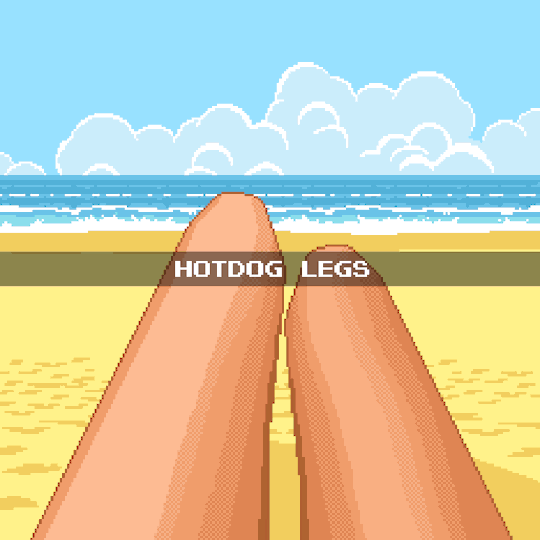
It’s Still (Pixelated) Hot Dog Legs Season
Fall should officially be in full swing by now, yet here in NYC (and many other parts of the US), it still feels like summer. Which I’m not thrilled about, though at the very least, I don’t feel so bad for sharing the above (by Robert Penney) so late into September.
On that note, time for a way overdue game culture round up! It’s been a while, and a LOT been going on. And not to be a downer, but the chaotic weather has been in the news, obviously.
Here’s a pic from Gamer Geek Nation on Facebook, who shared the aftermath of the Hurricane Harvey, along with: “… This is a time when we collectors need to remind ourselves that ultimately, this is just stuff, and our lives are more important. And make sure your collection is insured properly.”

Elsewhere in the world, the Tokyo Game Show just wrapped up, and not to repeat the obvious, but yes… the biggest, most exciting news was the Sonic X Hooters collab…

Though the one between Hello Kitty and Game Center CX is far, far better (photo courtesy of Kotaku)…

You also have this comically large Rockman doll, which apparently was available on Amazon but is now out of stock…

Though I mostly wished I had been there to pick up some primo looking attire, like this Mega Drive track jacket that miki800 gave the heads up on before show time (there was also a Dreamcast hoodie that I personally don’t think looks as nice, hence why I’m skipping it)…


I also really like this Pac-Man shirt…
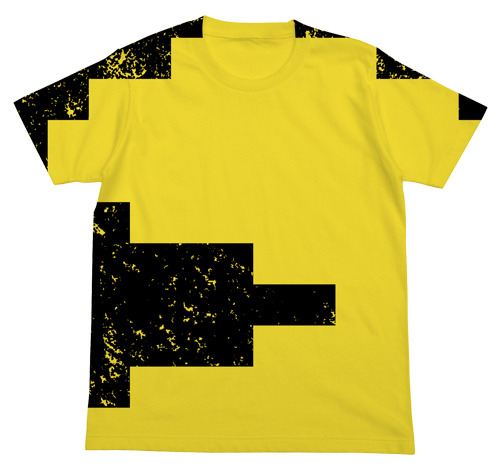
This Galaga shirt as well…
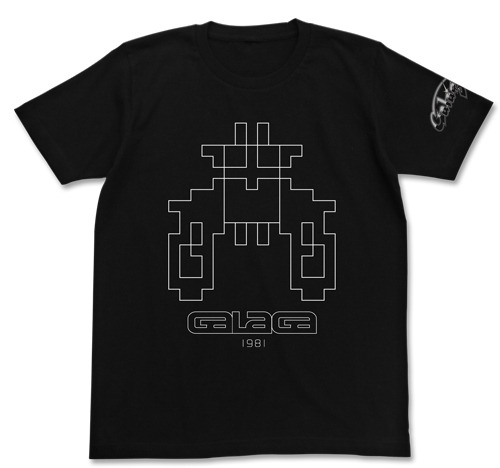
Also taking place in Japan was an exhibition held by the JARGA (Japan Retro Game Association); miki800 was there and captured some interesting bits of hardware, with the highlight being (IMHO) this Mega Drive clone that resembles a perfect mix of the model 1 MD and the original Wondermega…

There’s no preview of the music yet, though may as well share the recently unveiled cover to the third (and final) installment of 8 BIT MUSIC POWER…

Meanwhile, according to Original Sound Version, Mitch Murder has released yet another soundtrack to another game that never existed. In this it didn’t come out for the Mega CD and doesn’t involve mecha…

Remember that Jet Set Radio figure I showed a while ago? Well, it's finally available for pre-order! Alas, it's not cheap, at least over at Big Bad Toy Store...


BTW, videogamesdensetsu shares with us what Beat looks like, sans-cel shading…
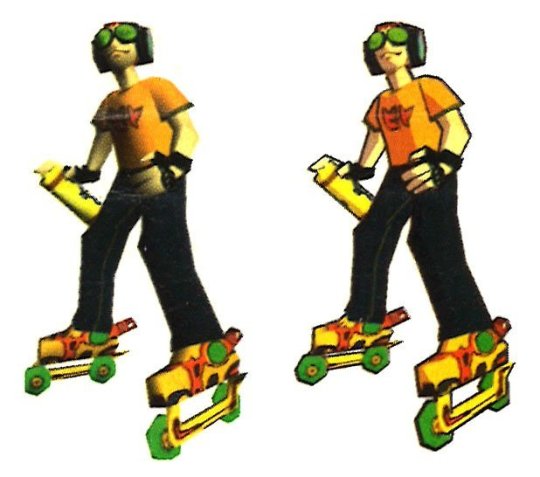
Sticking with VCD for a tad bit; here’s what Pulseman looked originally looked like, and he sure was cute!
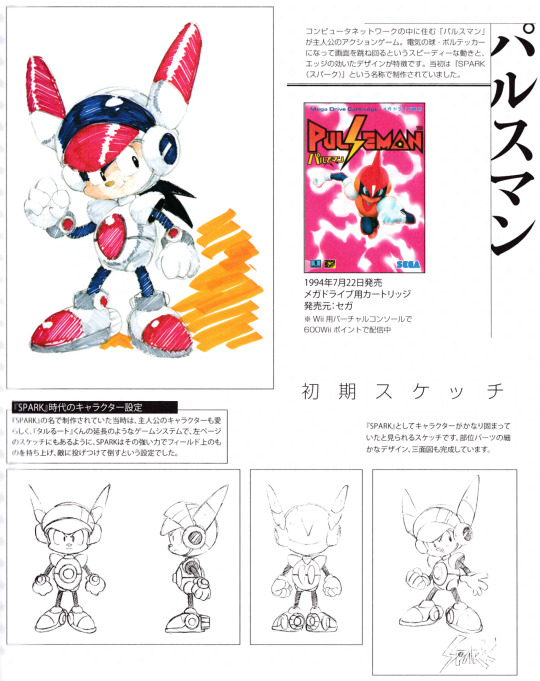
Whereas NiGHTS looked goofier… as well as more menacing….
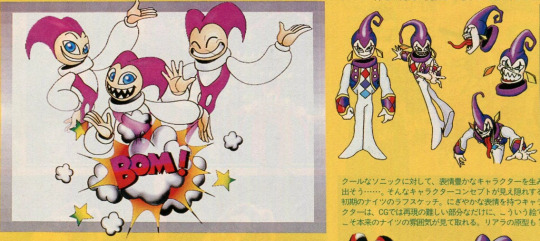
Am confident most people will not give a rat’s ass about seeing hand drawn Virtua Racing track designs, but as a massive fan of the series, oh man, oh man, oh man...

Two never before seen Saturn prototypes that must be: “[taken] with a grain of salt!”

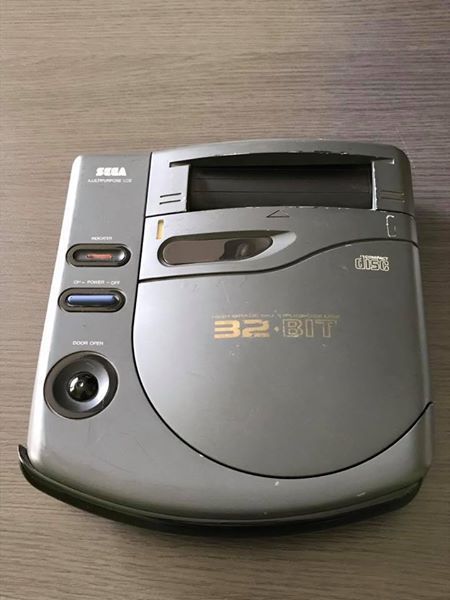
Apparently Looney Tunes X The Matrix was actually a thing? Somehow this does not surprise me…


The work of Hideaki Kodama was recently highlighted, which was also recently auctioned; I wonder how much this painting of various PC Engine hardware went for?

Yet another Kickstarter mention? Yup. And this one is Jed Henry's third crowdfunding campaign: this particular variant of the Ukiyo-e Heroes concentrates on boss battles, with perhaps my fave piece being his depiction from The Breath of the Wild...

Am particularly fond of this image from the Street Fighter 25th Anniversary art book that grease-howard spotted, of old Chun Li chumming it up with her younger self...

Any and all BoJack Horseman fans out there may want to pick up this piece by Jude Buffum...

legendofnes reminds of that time Batman visited New Donk City…

It's just a bunch of cyber kids, all just hanging around, by sanigo...
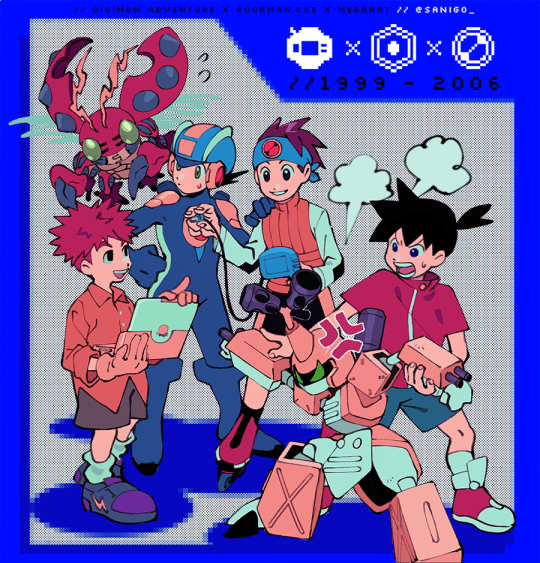
Speaking of the gang, here we have the kids from Persona 5, by @aranciart…

Apparently, if Jedah (from Darkstalkers) ran a juice stand, it wouldn’t be the best, according to dreaminerryday…

The individual who runs SPLENDID LAND describes SLN-003 Gacha Man as a: "vendor robot who dispenses toys. even he doesn’t know what’s inside the capsules, so he always gets excited to find out"...

Meanwhile, here’s official artwork of Mario and Peach, courtesy of the thevideogameartarchive’s catalogue of the Mario Golf N64 manual; am pretty sure I’ve seen images of Mario looking distressed, though never to this degree…
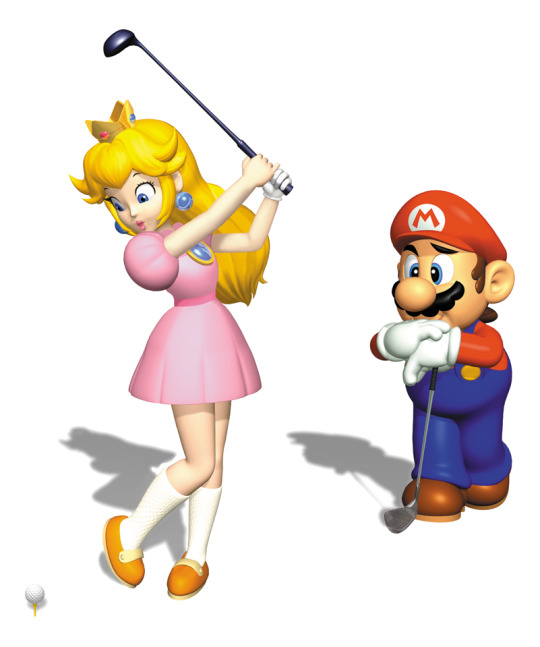
The above is something Super Mario Broth would normally deliver, and speaking of, may as well share some recent faves on that end! Like these photos from a promotional campaign with a Japanese sports drink when promoting Mario Sports Superstars…
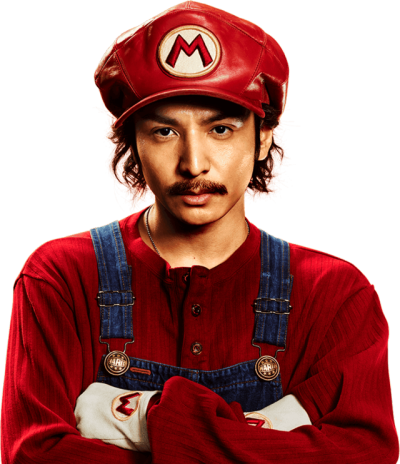
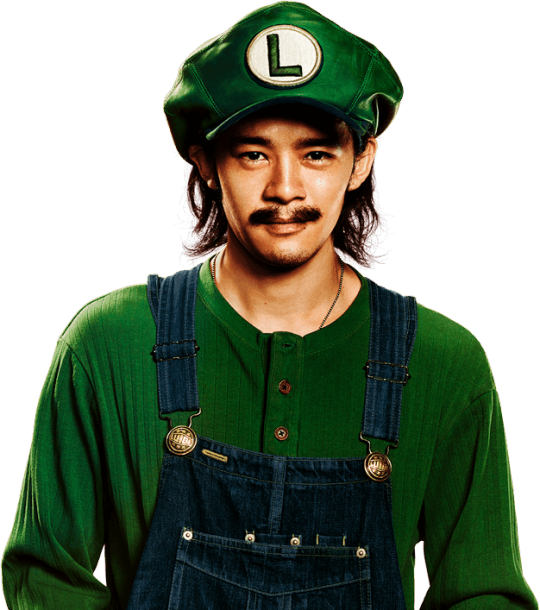
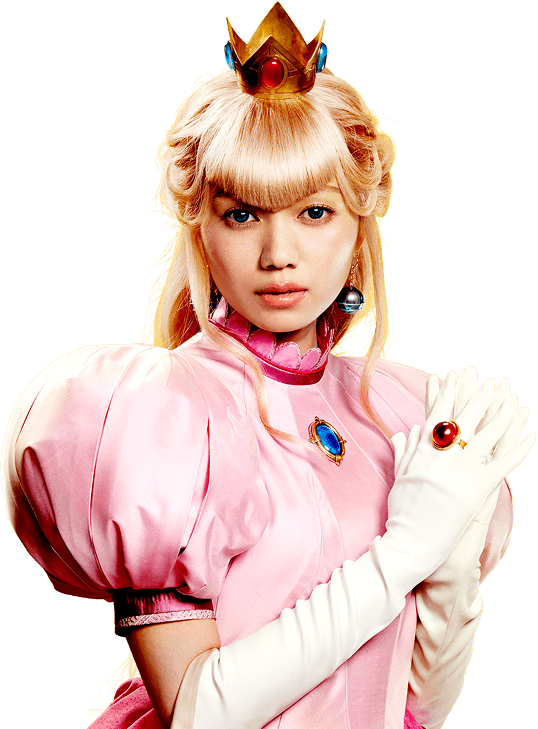
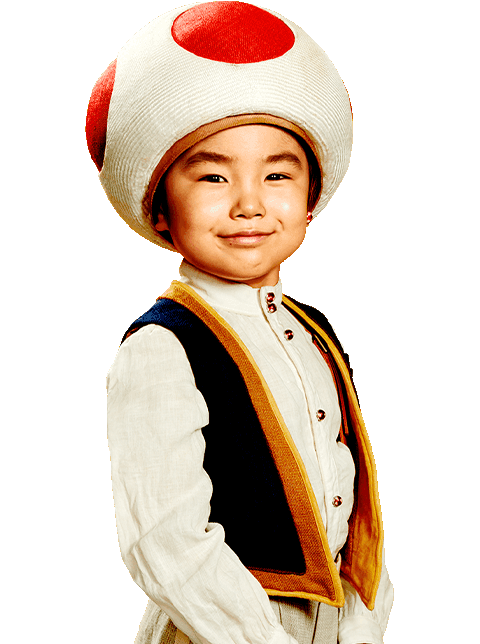
Instructions found on the arcade cabinet for Vs. Super Mario Bros (which I remember so distinctly, and fondly)…

From some Japanese video guide for the same game (am assuming the home Famicom version this time)…

A greeting card (am assuming a Valentine’s)...

Mario without his hat, as he appears in a Game Boy controller test cart that Nintendo service reps used to calibrate buttons on a the handheld…

And he we have a shortcut in SMB3 that I had no idea existed, and it’s a safe bet that most don’t either: “In Super Mario Bros. 3, the rock between the path to the first fortress in World 4 and the Spade Panel can be destroyed with a Hammer item, allowing the player to bypass the fortress. There is no obvious indication that this rock is destructible, as it is surrounded by decorative rocks. In fact, many guides for Super Mario Bros. 3 do not mention this shortcut.”

As for Super Mario Broth’s counterpart, Sonic the Hedgeblog has seen plenty of action as well… largely pinpointing all the obscure references found in Sonic Mania, So head over for that if that sounds like fun to you! Otherwise, there’s also the Mario Bros having a Sonic Panic…

A reminder of how Sonic looked at one point as he was being prepped for the Dreamcast; it would appear that at a certain point, in Sonic Adventure, he was going to look a lot more realistic…
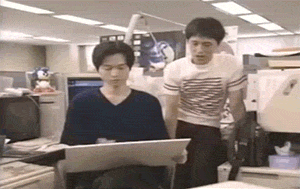
And this issue with EGM featuring a sneak preview of Sonic 2 is the very first video game magazine that I ever picked up!

Meanwhile, oldgamemags recently posted a page from an issue of GamePro, circa 2000, on a peripheral that allowed the Game Boy to play mp3s. Am sharing it cuz I really want a GB-looking mp3 player…
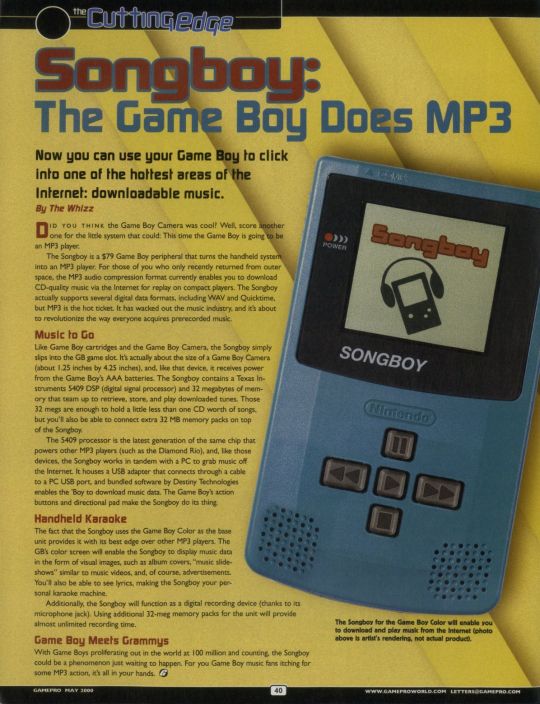
So someone on Twitter (who has since protected his account, so I’ll have to refer to nintendolife they snagged the pic before it was locked down) cracked open a electrocardiogram measurement instrument and found... a GBA? It’s theorized: “perhaps earlier revisions of the unit had different screens, and once the supply chain dried up MiE was forced to source the next best thing?”

vice-s-assistant sez: "OK Guys, I’m ready to hack."


According to bunney: "i was working at a convention arcade this weekend and some guy cosplaying ryu was playing street fighter with a blunt in his mouth"...

Can anyone tell what's being played here? At the very least, it's a nice shot (via rekall)...
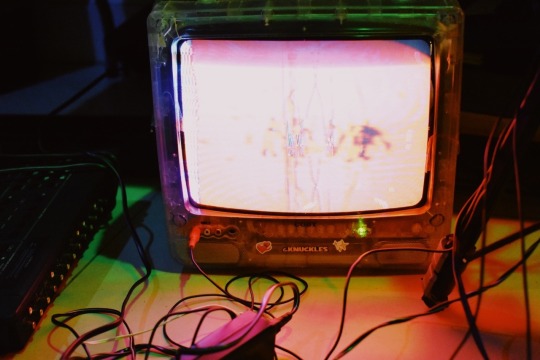
Much like Arcade Crusade, I have no idea what’s going on, and I agree that whatever it is, it looks intense...

If you’ve ever wanted an artist’s rendering of the Raspberry Pi, then look no further than the work of retronator…

rasec-wizzlbang states: “those square cross sections of the human skin layers you always see in biology books but as like, a minecraft block”…
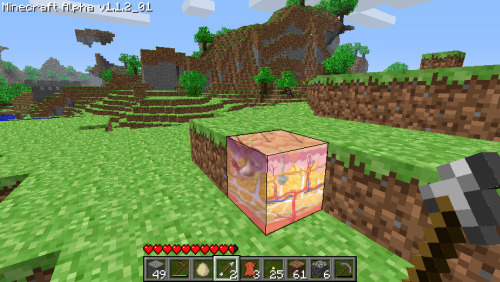
Courtesy of Arcade Crusade once again comes a very tender moment…

Is it just me or does this promo image for Food Fight sure does look like a Norman Rockwell painting? As seen on thedoteaters...
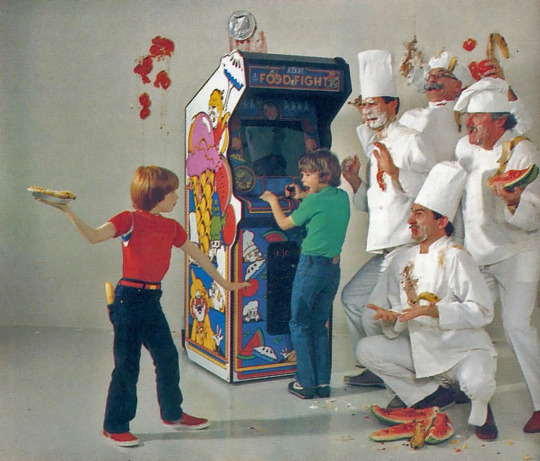
Here we have a flyer for a really old SNK arcade game (we’re talking really old; almost a decade before the Neo Geo was a thing) that looks like it was made with today’s sensibilities, doesn’t it?
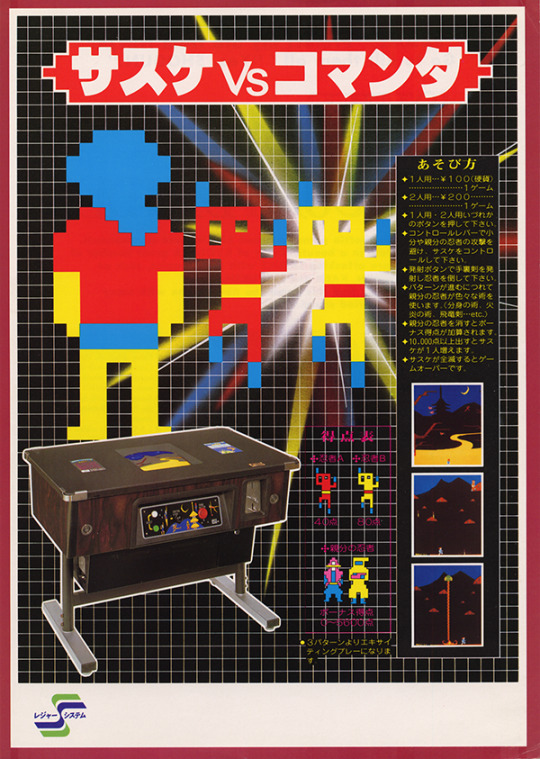
Also via obscurevideogames is a moment of pathos from Hacchake Ayayo-san 4 - Sexy Olympics - Ayayo’s Live Affection. It’s… pretty obscure alright…
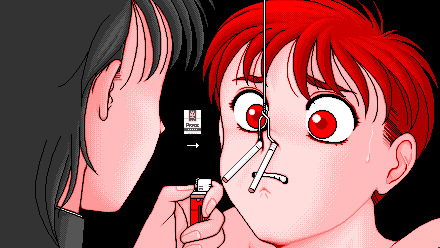
Yup, that's Hieronymus Bosch-styled Tetris all right (via freeindiega.me)...
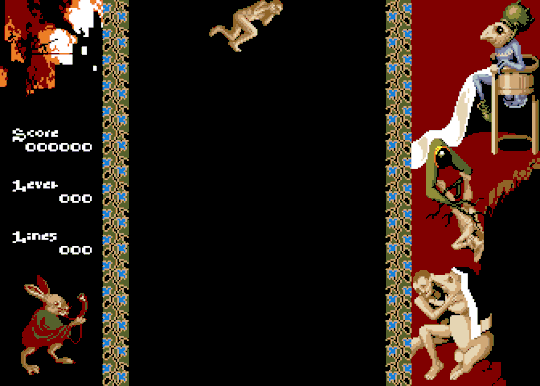
crashcarnival presents: "true facts of the Ice Age"...
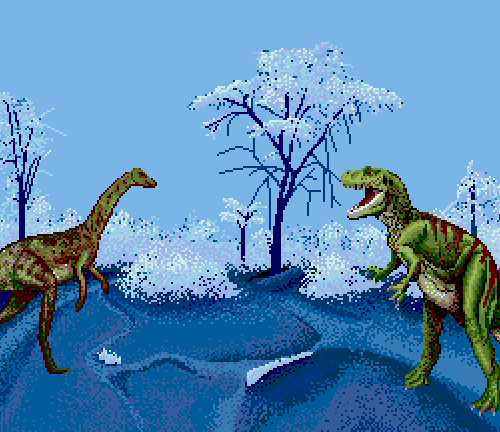
Hey, it’s the Ninja Turtles playing Pong (via rewind01)…
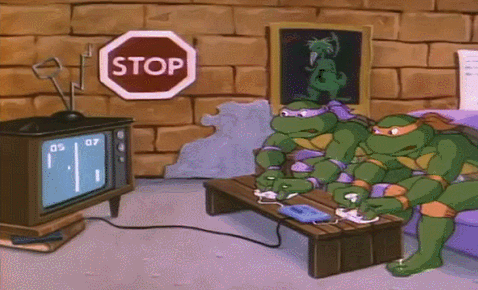
Behold, Fighters Megamix version 2017 (via lonelyfrontier)…
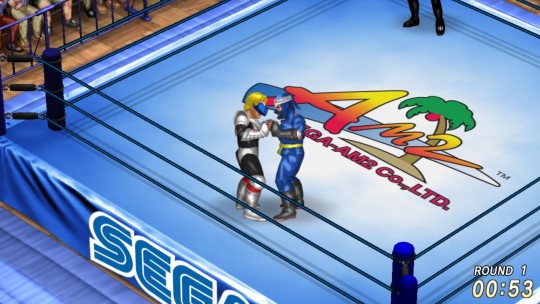
Yup, that is definitely a Chu Chu Rocket skirt (via radicalhelmet)...
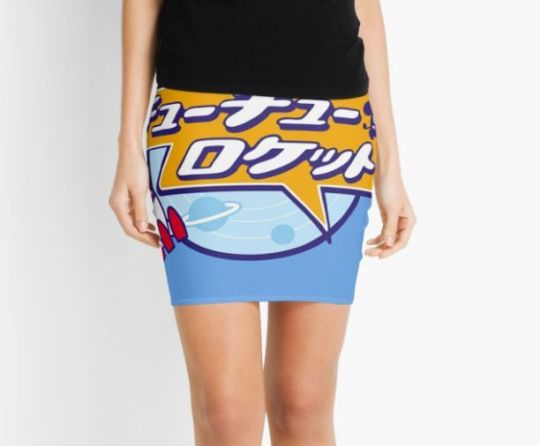
For those who have ever wondered what their Sonic character’s political leanings are, in relation to the rest of the crew (and can’t be bothered to sift through DeviantArt; via erratticusfinch)…
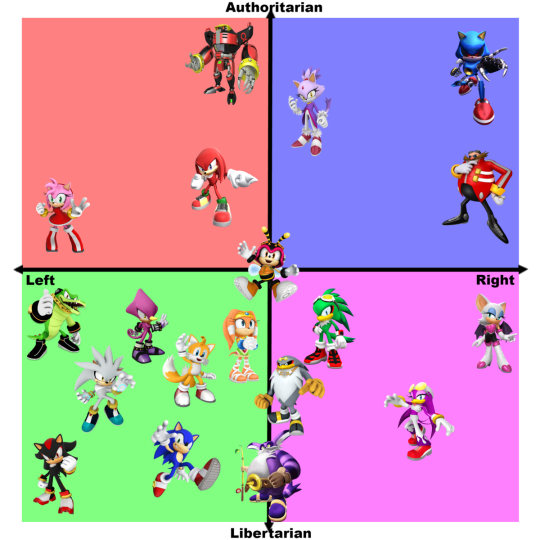
Face to face (via futureisfailed)…
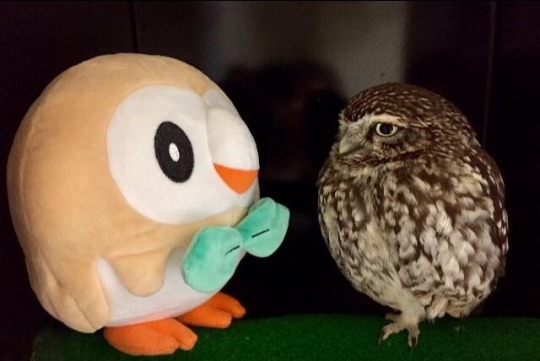
It’s been out for a while, though it’s not too late to pick up this Xenogears tribute zine, right?
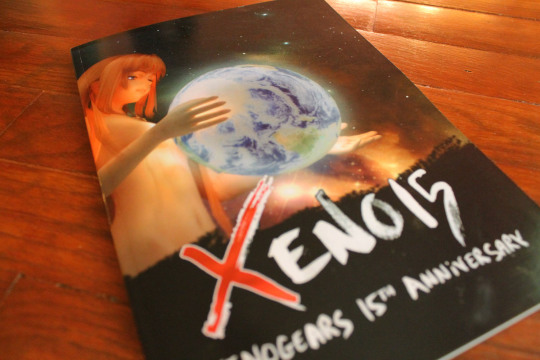
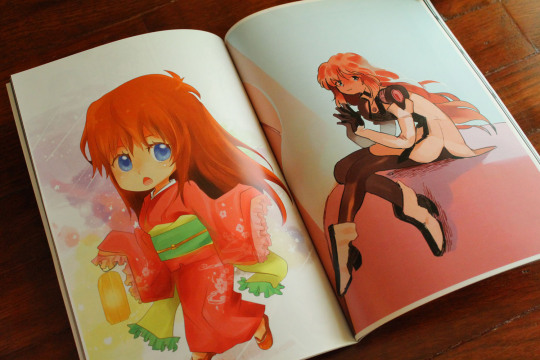
Just a friendly reminder of how bat-sh*t insane Sin & Punishment is (via n64thstreet)...

Zimmerit.moe has everything you need to know about a game by Square involving mecha that you’ve probably never heard of. And no, am not talking about Thexder; it’s even more obscure than that (am talking about Cruise Chaser Blassty BTW/FYI)...

Meanwhile, Michael “Kayin” O’Reilly discusses the “Barrel Distortion” look that emulators use to recreate the look of playing something on a CRT display and why it’s total crap…

And… that’s it! You’ve made it to the end! Enjoy a cool, refreshing drink with Pac-Man (on the behalf of arcade-crusade)...

Don’t forget: Attract Mode is now on Medium! There you can subscribe to keep up to date, as well as enjoy some “best of” content you might have missed the first time around, plus be spared of the technical issues that’s starting to overtake Tumblr.
4 notes
·
View notes
Photo

The best PS1 games of all time: From Symphony of the Night to Final Fantasy 7 http://bit.ly/2WiC9N8
Sony tentatively entered the video game market by partnering with Nintendo to develop a new, disc-based console in the mid-90s. After that partnership fell apart, Sony went on to release a console of its own.
The first PlayStation launched in Japan in late 1994, and in the following year, to the rest of the world. Although the PS1 wasn’t the first console to use CD-ROMs or provide true 3D graphics, it created the breakout moment for both of those technologies in gaming.
Ranging from novel-length, narrative-driven RPGs to fast and furious races to mind-bending puzzles, games for the original PlayStation offered a wildly diverse lineup over its 11-year production run.
Take a stroll down memory lane with us as we count down the 50 best PlayStation 1 games ever made. Do they hold a candle to the best PS4 games? You decide.
Action
Castlevania: Symphony of the Night

The Castlevania series was over a decade old by the time Symphony of the Night arrived, but it was absolutely the franchise’s defining moment. It radically expanded the series’ platforming with RPG loot and progression and non-linear exploration, lending its suffix to the subsequent “Metroidvania” genre as a result.
Unlike previous Castlevanias, where you controlled members of the vampire-hunting Belmont family, SotN revolves around Alucard, the lazily-named son of Dracula, who fights the horrible monsters of the castle to protect humanity from his father. Symphony of the Night stood out immediately for bold choices like hiding more than half of the game behind a false ending, or using the CD format to make a massive game filled with rich, 2D sprites instead of the crude, early 3D the rest of the industry was pursuing at the time.
One of the most influential action-RPGs of all time, Castlevania: Symphony of the Night is still just as satisfying to play now as it was 20 years ago.
Metal Gear Solid

Between Thief: The Dark Project on PC and Metal Gear Solid on PlayStation, 1998 was the year that modern stealth video games were born. A sequel to two lesser-known games from creator Hideo Kojima, you play as special ops soldier Solid Snake, infiltrating the hideout of a rogue unit threatening the United States with a nuclear strike.
Snake has a variety of tools for evading and taking out guards, making it one of the most taut and tactical gaming experiences available at the time. The series has since spawned four more critically-acclaimed main entries and various spinoffs, radically expanding upon both its deep gameplay and Kojima’s baroque, nuclear mythology. But the first Metal Gear Solid remains an unassailable classic.
Twisted Metal 2
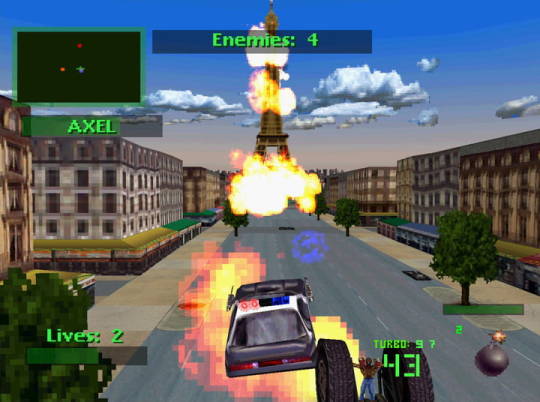
Prior to leading the team behind God of War, designer David Jaffe rose to prominence for his work on the PS1 vehicular combat series, Twisted Metal. In the demolition derby taken to a post-apocalyptic extreme, players take the wheel of various over-the-top armed and armored vehicles. Projectile weapons and power-ups are scattered throughout the arenas, set in the ruins of major cities around the world. The cars and drivers — like the series’ iconic ice cream truck, Sweet Tooth, and Axel, a muscle-bound man straddling two truck tires — ooze personality even in the early polygonal days of 3D.
The first game included only a single-player campaign and co-op mode, but the sequel expanded everything about it, including more vehicles, more arenas, and more custom and multiplayer modes for just dropping in and enjoying the mayhem à la carte. A contractual dispute between Sony and developer SingleTrac led to subsequent sequels being developed by other, less capable studios, making TM2 the peak of Twisted Metal for most fans.
Legacy of Kain: Soul Reaver

An action-focused spinoff of the top-down RPG series Legacy of Kain, Soul Reaver was a third-person action game from Crystal Dynamics, which would go on to earn acclaim with its reboot of Tomb Raider. You play as the ghostly vampire Raziel in the grimdark fantasy world of Nosgoth.
Players loved its dark, compelling narrative, voice acting, and varied mechanics. One of its main conceits was the ability to swap between the physical and spectral realm at any time. Crystal Dynamics was unable to simply layer two different versions of the world on top of one another because of the console’s limitations; achieving the effect was no small technical feat.
Legacy of Kain: Soul Reaver is also notable as one of the first major games written by Uncharted series scribe Amy Hennig, now considered among the best game narrative creators in the business.
Tenchu: The Stealth Assassins
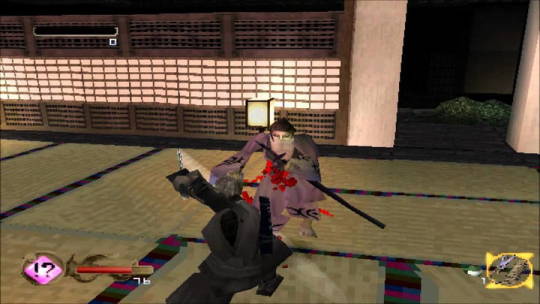
With their long-held mystique both within and beyond Japan, ninjas have featured prominently in video games since very early on. In franchises like Ninja Gaiden, however, they had largely been translated into nimble, hack-and-slash fighters. Tenchu: The Stealth Assassins is one of the first games to truly embrace the ninja as a stealthy infiltrator who must rely on his tools and wits to survive, rather than just weapons and reflexes. Developed by Japanese studio Acquire, Tenchu was the feudal Japanese parallel to Metal Gear Solid’s nuclear melodrama. Failing a mission would cause you to lose whatever tools they were carrying at the time, forcing you to be careful and deliberate when planning your approach to each mission. Fantastical elements from Japanese mythology provided fun flavor, but Tenchu was most fun because of how human and vulnerable you felt, making success all the sweeter.
Syphon Filter

Although somewhat overshadowed by Metal Gear Solid, Syphon Filter was another exceptional 3D, third-person action-stealth game for the platform that was praised at the time even if its legacy has not endured as strongly. Newbie developer Eidetic took equal inspiration from Goldeneye 007 on the Nintendo 64, hoping to create a “super-spy” hybrid genre with stealth, action, and puzzles.
It tells a gritty, contemporary story about special operatives facing off against biological terrorists in a world-spanning story that encompasses governments, multinational pharmaceutical companies, and conspiracies that run all the way up to the top. It was a pulpy and immersive plot, enhanced greatly by gameplay that was a compelling balance of stealth and straight-up action. Critics cued into its stellar AI, a key requirement for good stealth games, which was among the most impressive in any game to date.
Einhänder

Although best known at the time for its roleplaying games, Japanese developer Square was no one-trick pony. Case in point: It also gave us Einhänder, an absolutely fantastic side-scrolling shoot-’em-up in the tradition of Gradius (though not quite as extreme as the “bullet hell” subgenre that came after it).
Set in the future during a war between Earth and the Moon, you pilot a spacecraft through horizontal, 2.5D levels, destroying enemies and collecting power-ups. The name, a German word for a one-handed sword, alludes to the core mechanic of your ship’s sole grappling arm, used to pick up weapons scavenged from destroyed enemies. Weapons mostly have finite ammo, forcing the player to keep finding new ones and adapting their play style to what’s available.
Apart from the generally slick presentation, players loved the tactical variety enabled by the system of picking up new weapons, as well as the way that bosses had discrete parts that could be targeted and disabled. Although well outside of Square’s wheelhouse, many consider Einhänder to be one of the genre’s best, and Square’s finest non-RPG work to date.
Ace Combat 2

The original Ace Combat (released as Air Combat) was one of the first games released on the original PlayStation, and it showed. This sequel was an improvement by developer Namco in basically every way. Gameplay is divided into relatively linear, objective-based missions, with resources becoming available to upgrade your jets depending on how successful you were at destroying all targets.
It’s an arcade-style combat flight simulator, “arcade style” here referring to its gameplay-over-simulation design, with only semi-realistic physics and the ability to carry far more missiles than an actual jet could — though difficulty settings allowed more hardcore players to fly with greater realism if they so desired.
Mega Man Legends 2

Although the PlayStation hosted some of the best conventional 2D Mega Man games as well, it was also the exclusive home to some weird entries like Mega Man Legends, as well. With only the main character in common (and a cheeky reference to how he’s named after a character’s favorite video game), Legends is set in an archipelago where he travels around with the Caskett family of treasure hunters, scouring ruins for ancient machinery in search of the legendary Mother Lode.
In addition to refining the run and gun mechanics (replete with a fairly deep crafting and customization system), the second game also presented a much richer and more character-driven narrative than the structure typical to the core series of “hunt the bosses to get their powers.” The voice-acted cutscenes were particularly entertaining, feeling very much like watching an anime. It featured memorable characters like your nemesis, the pirate Tron Bonne, who had her own spin-off game between two Legends entries. A third game was canceled in development.
Tomb Raider 2

The original Tomb Raider essentially founded the genre of the 3D action/adventure game, but it’s the sequel that really made it sing. A radical departure from the cutesey, cartoon mascots of the previous console generation, international treasure hunter Lara Croft was immediately embraced as one of gaming’s most iconic characters, heralding the medium’s maturation.
The first game’s mix of exploration, platforming, combat, and puzzle-solving was expanded substantially for the sequel, with refined controls, bigger environments, and more exciting set-pieces. The third game felt a bit more like a rushed cash-in, leaving Tomb Raider 2 as the series’ peak for a lot of players until the universally-praised 2013 reboot.
Fighting
Bushido Blade
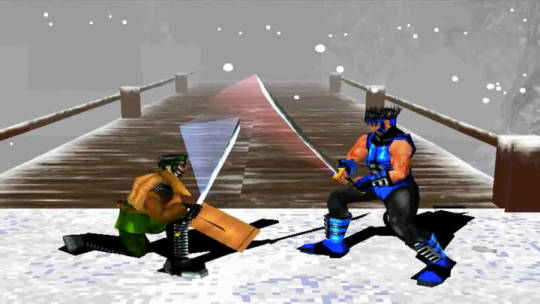
Feudal Japanese weapon-focused 3D fighting game Bushido Blade is the most well-known game from Japanese studio Light Weight, and it’s still somewhat anomalous within the genre. Eschewing the convention of health bars entirely, blows would either cripple particular body parts or kill you outright. This gave the game a rare degree of realism, and a much more tactical and punctuated tempo.
There were eight realistically simulated weapons and six characters with different stats, abilities, and proficiencies with each weapon, and a stance-based fighting system, giving players a lot of options. Also unlike the discrete levels of conventional fighters, its arenas were all inter-connected, and players could run and climb between them, using the environment to their advantage.
Bushido Blade had one direct sequel and another similar title on PS2, but those smoothed out some of its quirks too much for our taste. Other fighting games like the Soulcalibur series and more recently For Honor have explored weapons-focused “dueling,” but nothing has quite replicated what made the original Bushido Blade special.
Tekken 3

Street Fighter set the bar for 2D fighting games in the early 90s, but brawling in the third dimension was all about Tekken. This arcade-native franchise set the high bar for 3D fighters, perfecting the formula with the third entry. Where previous entries made relatively little use of the third dimension, depending on the character, Tekken 3 toned down the hyperbolic jumping and made it so every character could easily sidestep into the third dimension, opening up one of the most tactically complex and polished fighting systems in video games to date. A large and diverse roster of characters and truly impressive graphics for a home console port of an arcade game made Tekken 3 an instant classic, and it still holds the honor of being the second-best selling fighting game on any platform of all time, after only Super Smash Brothers Brawl.
Street Fighter Alpha 3

While Tekken and Bushido Blade blazed new paths for fighting games in the third dimension, Capcom stuck to its roots with Street Fighter, the fighting franchise that started it all. It featured a massive roster of 34 combatants drawn from the series’ whole history. It also introduced three different “isms” playstyles, changing the mechanics of how combos work and special moves charged up. While some felt that the 2D, sprite-based graphics dated the game, in retrospect it looks great, and holds up magnificently well as one of the most comprehensive and refined entries in the Street Fighter franchise.
Darkstalkers 3

Capcom was on such a roll producing top-notch fighting games during the ’90s that it sometimes overshadowed its own excellent titles. The Darkstalkers series of 2D fighters was always a cult and critical darling but had middling commercial success. Relatively standard (but solid) mechanically, it was mostly recognized for its anime-meets-gothic-horror aesthetic, with characters like vampires, mummies, demons, and a yeti. The look was magnificently refined by the time it hit the third game, with detailed and fluidly animated sprites that are among the best of the decade. First released in arcades, the game had undergone several character additions and balance changes by the time it was ported to PlayStation — all of which made it one of the fastest, fun, and charming fighters to play at home.
Platformers
Crash Bandicoot

Recently remastered in full, Naughty Dog’s original Crash Bandicoot trilogy (recently remade for PS4) endures as one of the most iconic 3D platforming series from the genre’s heyday. As the eponymous Crash, you are a mutant bandicoot (an Australian marsupial) on a quest to stop Dr. Neo Cortex from taking over the world with an army of other mutant animals.
The gameplay is standard for the genre — patrolling enemies, jumping challenges, power-ups, and collectibles, though levels were generally linear: It’s more Mario than Banjo-Kazooie. It was most highly praised at the time for its visuals, which felt more like a playable cartoon than any game to date. The vibrant character in Crash’s various death animations were particularly memorable in that regard.
Oddworld: Abe’s Exoddus

The original PlayStation was a fascinating, transitional period in game design, with a big uptick in processing power and storage opening up a whole new field of possible aesthetics to explore. Oddworld: Abe’s Oddysee was a cinematic platformer in the tradition of Prince of Persia or Another World. You play as Abe, an enslaved member of the Mudokon race, leading a rebellion against their corporate overlords before they are turned into a cheap food source.
It’s grim satire for sure, but full of warmth, humor, and loving attention to detail. As Abe explores, solves puzzles, and avoids enemies, he has to rely on his wits more than anything else, because he’s liable to die without much effort. The sequel, Abe’s Exoddus, picked up right after the first game and enhanced it with both quality of life improvements such as quick saving, and more elaborate puzzles based around communicating with NPCs. A recent, well-received remake of the original shows that there’s still a lot to be enjoyed in this classic series.
Rayman

Before designer Michel Ancel gave us Beyond Good & Evil (will the sequel ever appear?), he created one of the most enduring characters in platforming, Rayman. Released early in the PlayStation’s life cycle, Rayman was a stunningly colorful and charming 2D platformer, using the console’s 32-bit processor to present one of the most vibrant and detailed games to date. The story was light, fantastical nonsense, as the eponymous Rayman fought and jumped his way through various themed worlds to defeat bosses and save the day.
Rayman subsequently took a detour into 3D platforming as well, but his real legacy was secured in 2011’s Rayman Origins, which returned to the bright, animated aesthetic of the original. It didn’t rock any boats in terms of gameplay, but Rayman is still beloved as one of its generation’s most solid iterations on the platforming genre, which is still alive and well today.
Spyro 2: Ripto’s Rage

In the immediate wake of the Sonic vs. Mario console wars of the early-to-mid 90s, marketers still held onto the idea that a console needed a family-friendly platforming mascot to succeed. Next to Crash Bandicoot, the cutely-proportioned Spyro the Dragon competed for that spot on the original PlayStation.
En route to vacation, Spyro is pulled through a magical portal into a fantastical world under assault by a warlock who gleefully discovered there were no dragons to bother him. Spyro collects a series of MacGuffins to progress through nonlinear levels and unlock new traversal and combat abilities.
The whole first trilogy, developed by Insomniac Games, is well remembered for its colorful characters and solid platforming, but for our money, the second one hits the sweet spot of refined mechanics and freshness.
Klonoa: Door to Phantomile

The transition from 2D to 3D gaming produced a lot of interesting artifacts, but oddly enough, most developers didn’t think to try the intermediary style that’s grown more popular in recent years: so-called “2.5D” (action rendered in 3D but largely constrained to a 2D plane). This Namco-developed platformer is set in Phantomile, a fantastical realm manifested from the dreams that people forget soon upon waking.
You play as Klonoa, an anthropomorphic resident of Phantomile with a power-granting wind spirit that inhabits a ring. Gameplay is standard for the genre, with enemies, puzzles, and bosses spread out across themed levels. Praised by critics at its release, Klonoa can be hard to find now, particularly outside of Japan, but is fondly remembered as a solid and enjoyable platformer.
Jumping Flash!

Released in 1995, one year before Super Mario 64, Jumping Flash! holds the honor (according to Guinness) of being the first truly 3D platforming video game. Presented in first-person, you play Robbit, a robotic rabbit, exploring open levels to collect four MacGuffins (“jump packs,” in this case) to progress through its six themed worlds, each with a culminating boss battle after three levels.
Robbit’s ability to triple-jump mid-air is the game’s mechanical focus, supplemented by various power-ups with classic effects like temporary invincibility, extending the level time limit, or increasing Robbit’s health. Although it was soon overshadowed by the flourishing of 3D platforming’s imminent golden age, Jumping Flash! is still an innovative and under-appreciated trailblazer.
Ape Escape

In this third-person platformer you play a boy, Spike, tasked with travelling through time and using a variety of gadgets to capture hyper-intelligent apes that are meddling with history. It was the first game to require the PlayStation’s DualShock controller before the now-standard vibrating two-stick model came stock with the console. Rather than using the right stick to control the camera, it was used to manipulate the gadgets. Acclaimed at the time and fondly remembered since, it’s a seminal moment in platforming video games for both its cutting edge presentation and mechanics.
Puzzle
I.Q.: Intelligent Qube

The PlayStation’s most memorable games tended to be immersive fantasies, yet there were a few exceptions more purely focused on gameplay. I.Q.: Intelligent Qube was a 3D puzzle game in which a player ran around on a gridded platform, clearing cubes before they push him off into the void. It was a challenging brain-tickler, given more replayability with the ability to create new levels, a feature that unlocks after completing the game once. Although released in the West, it was most successful in its native Japan, garnering several sequels.
Super Puzzle Fighter II Turbo
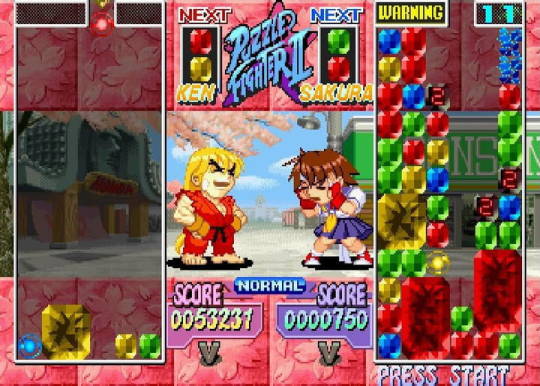
This port of a hit Japanese arcade puzzle game for one or two players isn’t actually a sequel to anything, but is cheekily named after Super Street Fighter II Turbo because it bolts the aesthetic and interface elements of Capcom 2D fighters onto a falling block puzzle. In it, Chibi versions of Street Fighter and Darksiders characters performed a silly battle that reflected what was happening in the puzzles.
Capcom developed the game for Japanese arcades in response to the popularity of Sega’s Puyo Puyo 2. It employed similar competitive mechanics to Puyo of successful chains dumping garbage blocks onto the opponent’s field, which could be countered with a quick combo in response. The charming 2D graphics and solid competitive puzzling mechanics have aged beautifully, maintaining this game’s reputation as a delightful cross-genre curio.
Racing
Gran Turismo 2
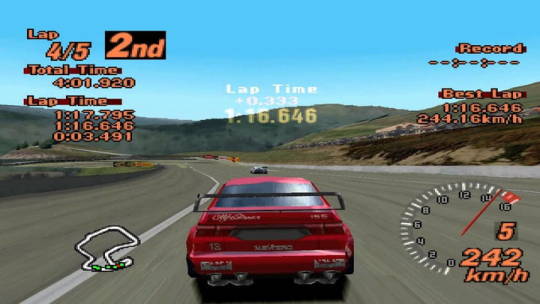
Hyper-realistic driving sims are flourishing, but Gran Turismo was the cream of the crop for virtual gearheads in the PS1 era. The smooth forms and inorganic materials of cars have always been an excellent test case for the cutting edge of realistic graphics, and as such Gran Turismo 2 was one of the first games where you might glance at the screen and think you’re watching live television.
The gameplay, graphics, and physics were largely unchanged from the first game, with the most notable expansion being in Gran Turismo 2’s enormous roster of real-world cars (over 600, the largest in any game to date), a robust customization system, and more flexibility to take part in races à la carte, rather than necessarily structured as tournaments. It was a bestseller among both car fans and regular gamers, establishing Gran Turismo as a key racing franchise that has endured through the present.
Wipeout XL

Like F-Zero on the SNES, the Wipeout series let players experience fantastical levels of speed in futuristic racing. Players piloted extremely fast, anti-gravity ships through dramatic, high-tech courses. Gameplay revolved around extremely high speeds, power-ups, and utilizing air brakes for drifting turns around tight corners.
Expanding and improving upon the first game in nearly every way, Wipeout XL was praised for its intense gameplay and slick presentation, including a techno music soundtrack and detailed background worldbuilding that made it feel like the immersive, futuristic entertainment video games had promised to become since the 80s.
Crash Team Racing

Mario Kart clones flourished on all consoles in the years following the success of Mario Kart 64, and Crash Team Racing was handily the best available on the PlayStation. Developed by Naughty Dog, it featured characters from the Crash Bandicoot trilogy kart racing for up to four players. Like its obvious inspiration, it featured aggressive and speed-boosting power-ups, drift turning, and whimsical, elaborate courses.
Unlike Mario Kart games, in addition to standard, time trial, and battle modes, it also included a story that progressively unlocked additional characters and modes as players completed it. For the most part, it didn’t shake up the formula in any substantial ways, but it was a solidly designed, good looking, and fun game that filled a definite niche for PlayStation owners. Not every great game needs to reinvent the wheel, after all.
R4: Ridge Racer Type 4

Between the simulation-focused realism of Gran Turismo and the wacky hijinks of Kart racers, you have Ridge Racer. R4, the Namco-developed series’ final entry on PlayStation, looks like the former, but plays closer to the latter. That made it perfect for racing fans who wanted the fantasy of realistic-looking cars but were turned off by realistic handling. 321 vehicles to unlock and a variety of tracks and modes make this a great package for anyone who wanted a rich, arcade-style racing experience. Many still consider it the peak of the Ridge Racer series.
Driver: You are the Wheelman
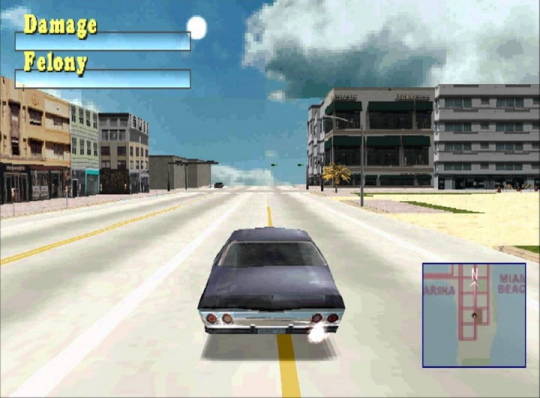
While most driving games framed the action around races, Driver instead sought to recreate the feeling of 60s and 70s car chase movies like Bullitt or 1978’s Driver. Set in open-world urban environments inspired by real cities, Driver looked forward to the sort of hijinks that would come to define Grand Theft Auto games, like escaping from cops or smashing up other cars. It also included an interesting Film Director mode that allowed players to capture replays with particular camera angles.
Rhythm
PaRappa the Rapper
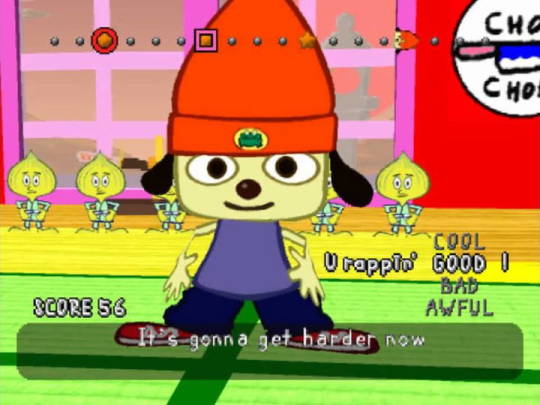
Before Harmonix made the genre blow up with Guitar Hero on the PlayStation 2, PaRappa the Rapper was the name in rhythm games. Sidestepping the crude stabs at realism that contemporary developers were making with the console’s nascent 3D tech, PaRappa features colorful, 2D characters in 3D environments. This highlighted design over horsepower, decades ahead of current trends to integrate 2D and 3D artwork into more visually interesting aesthetics than the brown-grey realism that dominated the early part of the millennium.
PaRappa’s bright and cheery look was a 90s hip-hop Day-Glo fantasia, and the music, while lyrically inane, holds up shockingly well over 20 years later. PaRappa the Rapper has been technically surpassed by subsequent rhythm games in nearly every regard, but it’s still rightly beloved as a groundbreaking curio from a time in gaming before genres became quite so crystallized and anything felt possible.
Vib-Ribbon
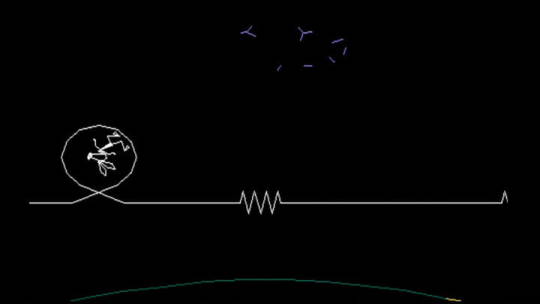
Although Vib-Ribbon is one of the most visually primitive games ever released for the original PlayStation, ironically it could now most easily be mistaken for a contemporary indie title. In this minimalist rhythm platformer, you play Vibri, a rabbit who must traverse courses generated procedurally from the music, all rendered in simple, white, line vector graphics on a black background.
The game’s lightweight visuals meant that it could be loaded entirely into the console’s RAM, and thus players could generate levels based on any music CDs they put in. Using CDs to generate material for games had been explored on PlayStation already in Monster Rancher, but Vib-Ribbon was the first to integrate the content itself into the game. Well ahead of the curve for both rhythm games and minimalist, procedural platformers, Vib-Ribbon feels nearly timeless now.
Role-playing
Final Fantasy IX

Breaking off from the trajectory of Final Fantasy VII and VIII toward gritty sci-fi, FF9’s return to the stylized, chibi aesthetic and light-hearted fantasy of the series’ original entries left many fans turned off. In retrospect, it stands out as a fantastic synthesis of the franchise’s recent ideas with its classic mechanical and worldbuilding tropes. It follows the rogueish Zidane, the rebellious princess Garnett, and their assembled friends taking on the sinister Queen Brahne and her world domination plans. It’s classic Final Fantasy through and through, and is easily the most charming and fun entry from the era.
Final Fantasy VII

Perhaps the most famous entry of the premier Japanese RPG franchise, FF7 was a massive, breakout event for the series, breaking into the third dimension and reaching far wider audiences than ever before. It tells the tale of mercenary Cloud Strife and his ragtag friends taking on the sinister Shinra Corporation, which is literally draining the planet’s life force. The chunky, polygonal visuals haven’t aged well, but characters like Sephiroth and moments like the death of Aeris loom large for gamers (as evidenced by the hugely hyped remake in the works), making this still one of the most influential and well regarded RPGs of all time.
Chrono Cross

Squaresoft RPG Chrono Trigger is still widely considered one of the greatest video games of all time. Its PlayStation sequel never achieved the same reputation, but it’s nevertheless a fun and interesting game that holds up quite well. Like the first game’s different time periods, Chrono Cross’ primary narrative conceit was jumping back and forth between two parallel timelines, in one of which the protagonist had died as a child.
The game features over 50 recruitable characters, each with their own personal quest to follow, making it literally impossible to see everything in a single playthrough. The connections to the first game are non-obvious at first, but ultimately it ties them all together in an interesting and resonant tale that frequently meditates on loss and regret. It’s also colorful, fun, and features unique approaches to both combat and progression.
Xenogears

Another fiercely loved Squaresoft RPG, Xenogears started as a pitch for Final Fantasy VII, but eventually spun off to start its own science fiction franchise. Long and ambitious, it amazed some and perplexed others with the plot’s complicated political and religious themes, along with a healthy dollop of Jungian psychoanalysis.
You play as the amnesiac young man Fei Fong Wong in a quest to save the world from Deus, an ancient, planet-killing weapon that has gained sentience. Gameplay featured both conventional, Final Fantasy style active time battles, as well as fights in the eponymous Gears (giant mecha suits) that involved managing action points and developing combos. The first Squaresoft RPG to feature voice acting and anime cutscenes, Xenogears was a leap forward in the medium’s potential for mature and cinematic storytelling.
Vagrant Story

Yasumi Matsuno’s action RPG stood out from its peers at Square because of its razor focus. Rather than assembling a ragtag crew of wacky misfits to save the world, you play a single character, Ashley Riot, a knight sent after a cult leader who kidnapped a noble family and absconded to a ruined medieval city, Leá Monde.
Like Parasite Eve, it featured pausable, real-time combat and the ability to target and be targeted on particular body parts, crippling particular capabilities. Combined with an elaborate weapon crafting and armor system, it provided a rich and focused tactical playground that players enjoyed experimenting with for years. It was essentially retconned into Ivalice, the world of Final Fantasy Tactics and XII, but even without that it would stand alone as a beloved classic for its mature story and mechanical depth.
Final Fantasy VIII

Following the explosive, global success of FFVII was a tall order, but Square managed to keep aggressively evolving the series for its immediate sequel. Final Fantasy VIII was the first in the series to feature realistically proportioned characters and continued the move from 7 towards the fantasy-infused sci-fi aesthetics that defined later entries.
The story revolved around Squall Leonhart and a party of other freshly-trained SeeD mercenaries in a quest that quickly turns from political to world-ending stakes. Fans also latched onto the romance between Squall and fellow party member Rinoa, which featured an original vocal track (a series first), “Eyes on Me” by Chinese singer Faye Wong.
The game was a radical departure mechanically, getting rid of magic points in favor of the elaborate “Junction” system of drawing finite quantities of spells from enemies that you could either cast or hold onto in order to buff up particular stats. It was an odd system that didn’t make it into subsequent entries, but demonstrated the franchise’s ongoing willingness to reinvent itself in core ways.
Suidoken II

While widely beloved by fans and critics, Suidoken II’s limited print run and distribution prevented it from reaching the universal acclaim that Final Fantasy games found on the PlayStation, at least in the West. Loosely based on the plot of a classical Chinese novel, it was most praised for its story: a complex and mature political saga of warring nations and city-states struggling for independence.
The scope of that narrative was reflected in the scope of the party you could recruit, with over 100 characters able to join you through personal side quests (though not all in combat roles). It featured both standard turn-based party battles in the vein of Final Fantasy as well as large-scale, strategic engagements on a grid more reminiscent of Fire Emblem. Suidoken II was about as epic as you could get on the PlayStation.
Legend of Mana
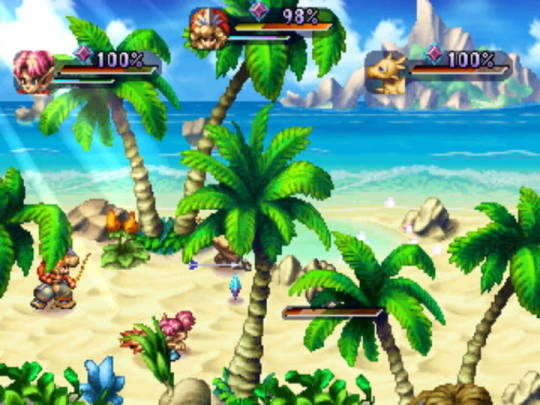
The Secret of Mana series grew up alongside Final Fantasy in the 8- and 16-bit eras (the first game was actually sold in the United States as Final Fantasy Adventure), generally taking a slightly lighter tone and substituting the turn-based battles with more open, action RPG gameplay. Legend of Mana is the fourth entry (following the fantastic Seiken Densestsu 3 for SNES, which has still not been officially localized in the west).
A recurring theme on this list, the storage and processing power of the PlayStation was leveraged not to make crude stabs at 3D graphics but to fill it to the brim with lush, beautiful 2D graphics, universally praised at the time as looking like an animated film, and aging exceptionally well.
Set after a cataclysmic war, the player is tasked with restoring the land of Fa’Diel (and eventually the Tree of Mana itself) by literally placing parts of the land on the map that have been sealed in artifacts, with their relative placement affecting things like the strength of elemental magic types in each region. It was criticized at the time for making the story feel too diffuse, but in retrospect, its nonlinear, system-rich approach feels ahead of its time.
Wild Arms
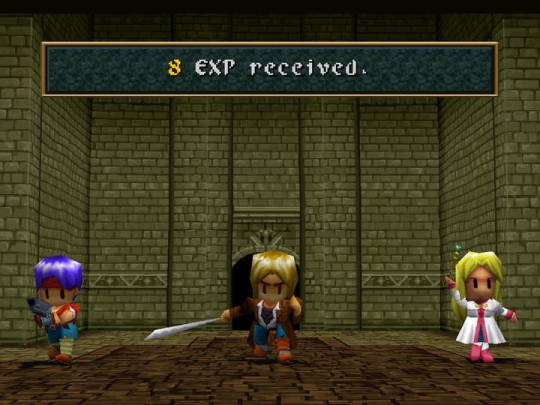
One of the first RPGs released for the PlayStation, Wild Arms stands apart also for its highly-unconventional setting that blends traditional JRPG fantasy tropes with visual elements from the American old west. Set in the world of Filgaia, you play a scrappy band of wandering adventurers called Dream Chasers, including a boy, Rudy, who can excavate and use ARMS (Ancient Relic Machines — basically guns from a lost era of greater technology).
Using both 2D sprites for exploration, and 3D rendered battle sequences, Wild Arms was an interesting transitional game between the 16- and 32-bit eras. Mostly it stands out for its compelling setting, however, fusing science and magic in a way reminiscent of — but also completely distinct from — Final Fantasy VI.
The Legend of Dragoon

Sony may have set unreasonable expectations for The Legend of Dragoon by marketing it initially as a “Final Fantasy Killer,” but this SCE-developed RPG has endured as a cult classic of the era. You play as Dart, an orphaned survivor of a destroyed city rescuing his childhood friend, kidnapped by a rebel army.
In typical genre fashion, he assembles a motley crew for a quest that spirals up to defeating a world-ending god of destruction. It fleshed out the typical turn-based combat with a system of combos and counter-attacks that added an interesting dimension of timing and risk/reward. While it never panned out into a franchise, it’s just as well-written and designed as many of its more widely beloved peers.
Legend of Legaia
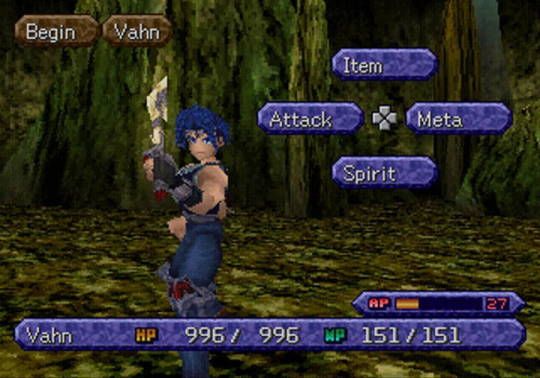
While much of the flourishing RPG genre was simply following in Final Fantasy’s footsteps, Legend of Legaia had the hipster appeal of trying to do something different. The story was standard genre fare: A martial artist from a village at the edge of the world, you set out on a quest to beat back the Mist that has consumed the surface and spawned countless monsters, pushing humanity to the brink.
Legaia stood out for its combat system, which was turn-based but also heavily derived from fighting games. Rather than having a generic “fight” option in battles, players targeted different strikes as left, right, high, or low, chaining them together into increasingly elaborate combos as the game proceeded. It added a tactical richness to combat that few of its peers could match, and is a franchise worth re-examining.
Parasite Eve

Adapted from a popular, contemporary Japanese novel of the same name, Parasite Eve was a bit of a genre hybrid from developer Square. Equal parts action RPG and survival horror, it follows a New York City cop trying to stop an entity named Eve from destroying humanity through spontaneous combustion.
Like Square’s Vandal Hearts, it featured pausable real-time battles and the ability to target particular body parts, with abilities tied to the “Active Time Bar” (ATB) system pioneered in the studio’s Final Fantasy games. Critics praised its interesting and immersive design at the time, although its legacy was somewhat overshadowed by the more “pure” RPGs and survival horror games of the time, respectively. In retrospect, however, its infusion of RPG progression systems into a survival horror framework can be seen reflected in more modern games such as The Evil Within, although its pausable real-time combat has been less explored subsequently.
Shooters
Medal of Honor

Several years before the original Call of Duty kicked off the oversaturation of WW2 first-person shooters in earnest, Medal of Honor set the bar. Steven Spielberg developed the story, working with the same historical military consultants he collaborated with on Saving Private Ryan.
Where previous shooters had been relatively light-hearted affairs about blasting hordes of demons, Medal of Honor was one of the first serious, cinematic shooters that presaged future classics like Spec Ops: The Line by exploring the medium’s serious narrative potential. Critics and fans also praised its gameplay, however, as one of the most generally refined shooters released to date.
Sports
Tony Hawk Pro Skater 2

The original Tony Hawk Pro Skater was an enormous success when it launched in 1999, but it was the follow-up from the next year that truly cemented it as one of the most beloved sports franchises of all time. The action centered around arcade-style gameplay, with the player flipping and grinding over open levels to rack up as many points as possible from tricks and combos within two minutes.
Collectibles and level-specific objectives keep it spicy, and the addition of level- and skater-creation tools gave it a ton of replayability. The series continued through the ill-received Tony Hawk Pro Skater 5 in 2015, but for many, the second remains the definitive entry and still one of the most highly rated sports games of all time.
Madden NFL 98
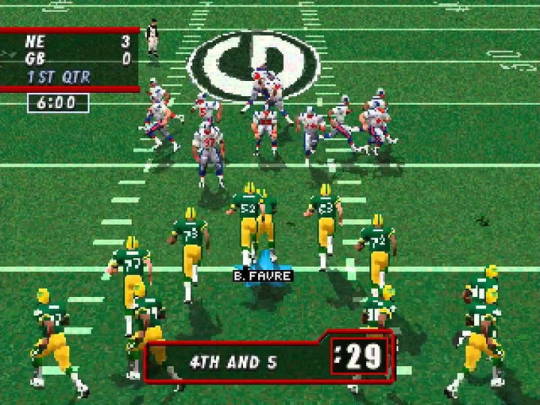
1997 saw the Madden football franchise’s first stab at 3D with Madden Football 64, but for our money, the best sports game of the year was the less ambitious and far more refined Madden NFL 98. While other franchises made the leap to polygons, development efforts at Madden instead were focused between 97 and 98 on punching up the game’s artificial intelligence, which made this the most strategically sophisticated football game ever released at the time. As is often the case from this era of consoles, Madden NFL 98’s late 2D sprite graphics hold up better than the early efforts at 3D that followed it.
Strategy
Final Fantasy Tactics

FFT wasn’t the first tactical RPG to come out of Japan — the Shining Force and Ogre Battle series already broke that ground for western console audiences. It’s far and away the most beloved and influential one, however.
The series’ traditional linear battles of three to four party members lined up facing a few enemies. In turn, Final Fantasy Tactics opened up into a much richer, isometric, grid-based combat reminiscent of X-COM, with an elaborate job system allowing for deep, strategic party customization.
Set in the world of Ivalice (which was featured in later entries like FF12), it tells a mature tale of competing noble families, warring nations, and the intersection of church and state. Spin-off sequels for the Game Boy Advance were solid, but none ever quite captured the magic of the original.
Survival horror
Resident Evil 2

While the first Resident Evil is beloved for creating “Survival Horror,” Resident Evil 2 perfected the formula. It picks up two months after the events of the original, as the Umbrella Corporation’s zombie plague spreads from the company’s labs to nearby Raccoon City. Like the first game, it features two protagonists, puzzles, exploration, and limited resources for ammo and saving the game, forcing careful and strategic play.
It added the “Zapping System,” in which players could revisit scenarios multiple times as different characters, with unique challenges designed for each of them. Its presentation was also praised as improving upon the first game in virtually every way. Though the series has continued for decades — we’re up to Resident Evil 7 as of 2017 — many still consider the second the high watermark. Resident Evil 2 also received a stellar remake in 2019.
Silent Hill

The PlayStation’s 3D capabilities opened up a whole field of possibility for cinematic horror, which is why the survival horror genre was born on it. Where the early Resident Evil games relied more on jump scares and zombie movie tropes, Silent Hill took a decidedly more psychological and surreal approach.
You play as Harry Mason, searching for his daughter who goes missing in the creepy town of Silent Hill while passing through on vacation. The whole town was blanketed in a thick fog, cleverly utilized to cover for the system’s draw distance limitations, which gave the game a memorably menacing atmosphere, particularly when played alone and late at night.
Drawing from an interesting range of influences like Lewis Carroll and David Lynch, Silent Hill is seminal in establishing the subtler and more artistically interesting strain of psychological horror in video games.
Resident Evil

Released first in Japan as Biohazard, Resident Evil is Shinji Mikami’s genre-defining survival horror opus. Although not the first horror game, it exerted such a gravitational pull that, like shooters in the wake of Doom, any other entries in the genre were called an imitation for a while — and it’s still basically impossible to talk about survival horror without Resident Evil featuring prominently in the discussion.
You play as Chris Redfield and Jill Valentine, special forces units sent to investigate their missing teammates in a zombie-infested mansion on the outskirts of Raccoon City. It established the now-standard genre gameplay of careful exploration, puzzle solving, and resource management. Players remember it most fondly for its creepy atmosphere and unsettling presentation, however, making clever and efficient use of the hardware with 3D characters on pre-rendered backgrounds to achieve unprecedented immersion.
Dino Crisis

If you liked the survival horror stylings of Resident Evil auteur Shinji Mikami, but weren’t into zombies, Capcom still had you covered. Much of the same team including Mikami himself also developed Dino Crisis, a survival horror game set on a secret island research facility wherein genetically-revived dinosaurs run rampant, Jurassic Park-style. Capcom contrasted it with Resident Evil by marketing it as “Panic Horror” rather than survival, because of the emphasis on dinosaurs as a quicker and more aggressive/intelligent threat than zombies.
Unlike the pre-rendered backgrounds of its predecessors, Dino Crisis featured real-time 3D environments, adding to the sense of immersion. Although not quite as viscerally scary or enduring a franchise as Resident Evil, many felt that it improved upon those games in nearly every way, offering a tense, fun, and more consistently paced experience.
The best Xbox 360 games
The best NES games of all time
Collected ’em all? Here are 10 collection-based RPGs Pokémon fans should try
0 notes